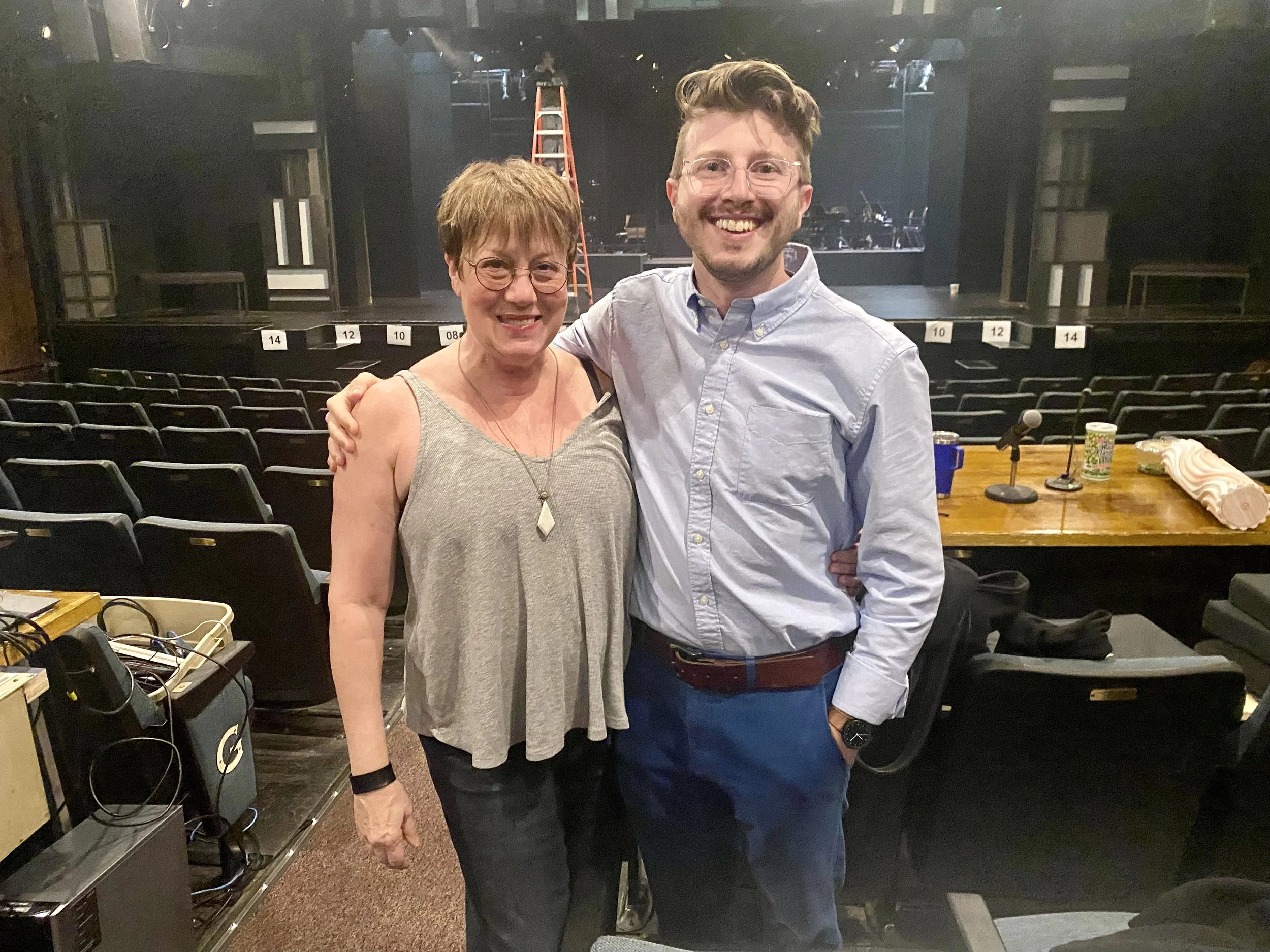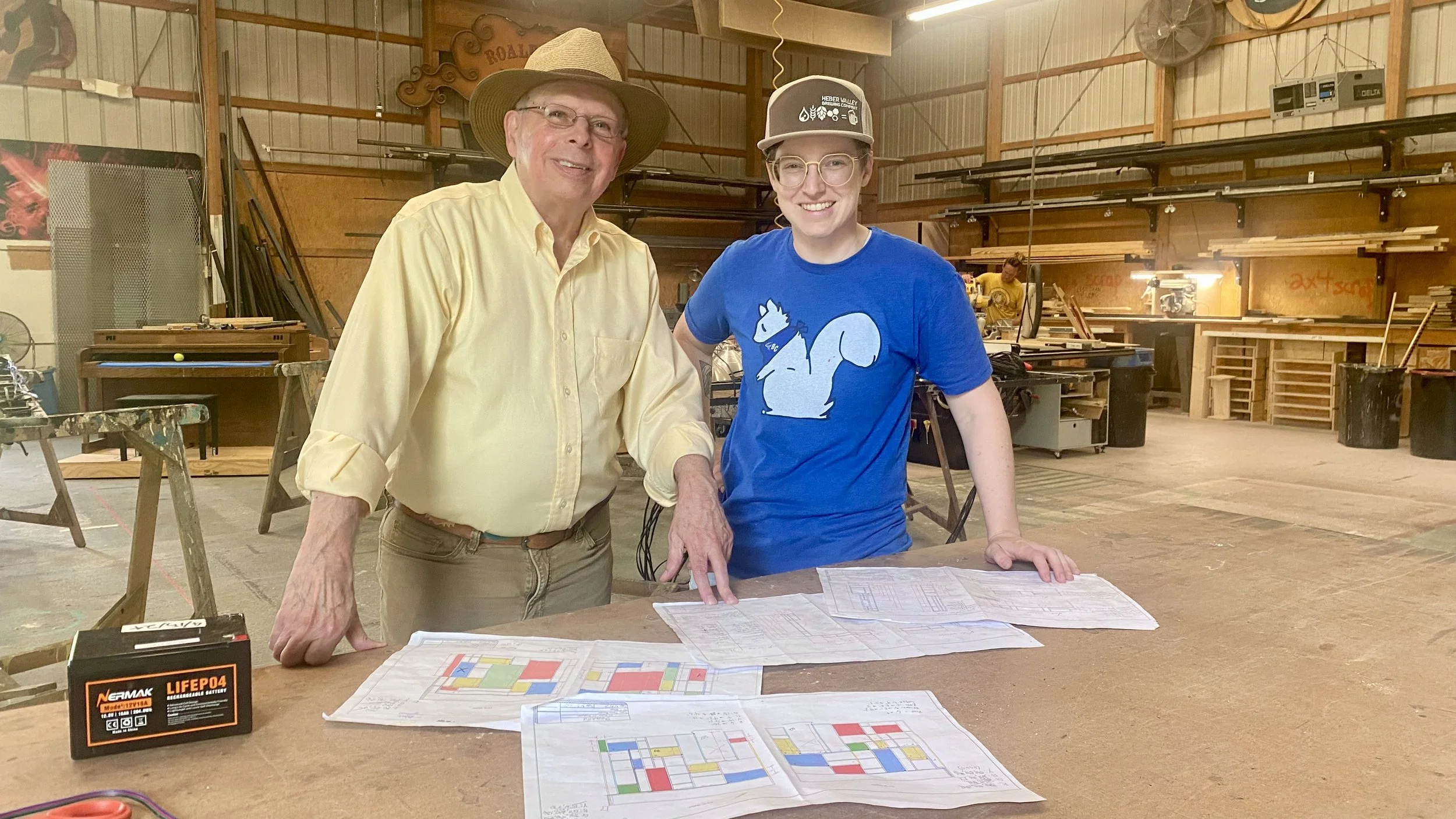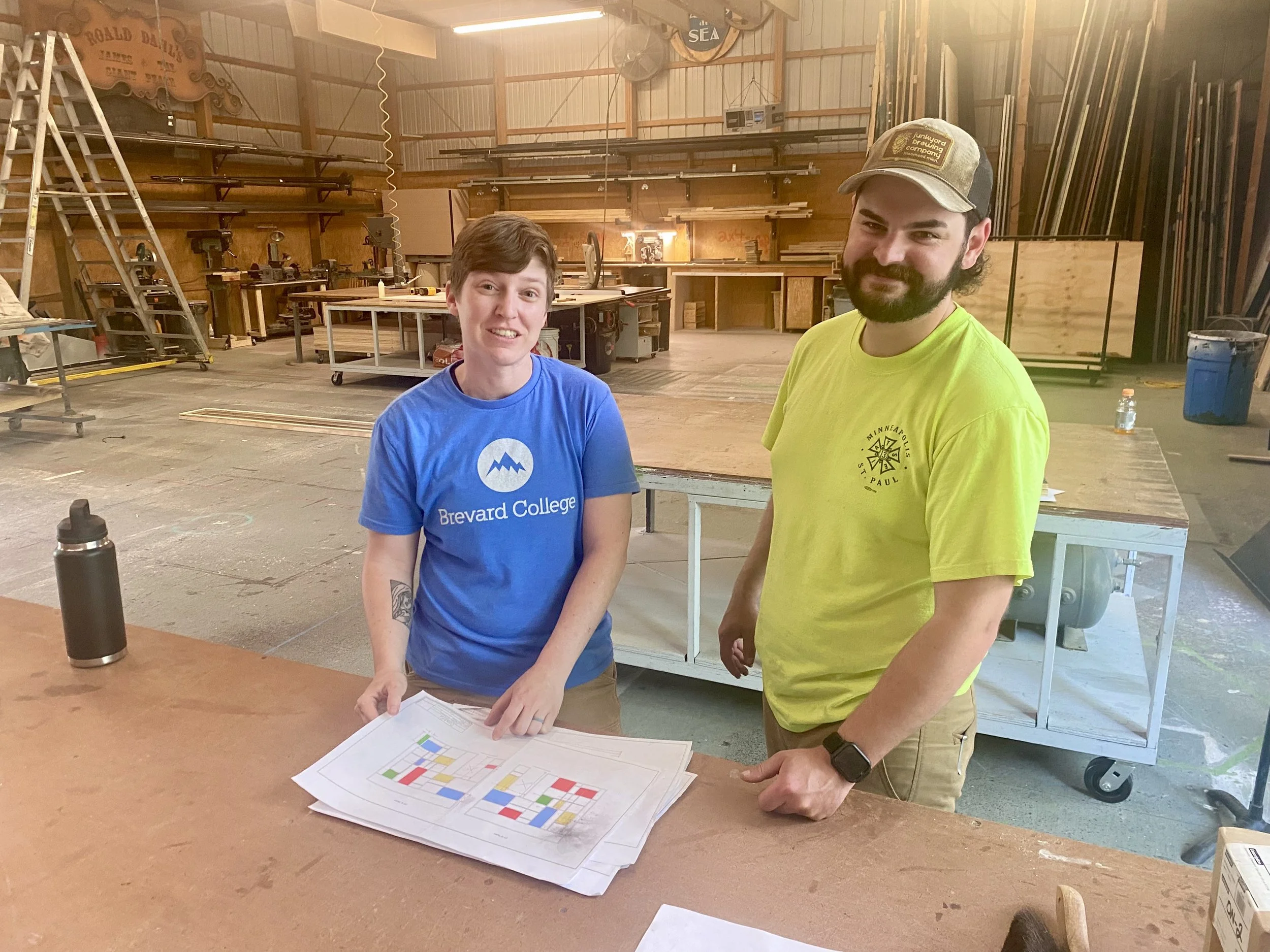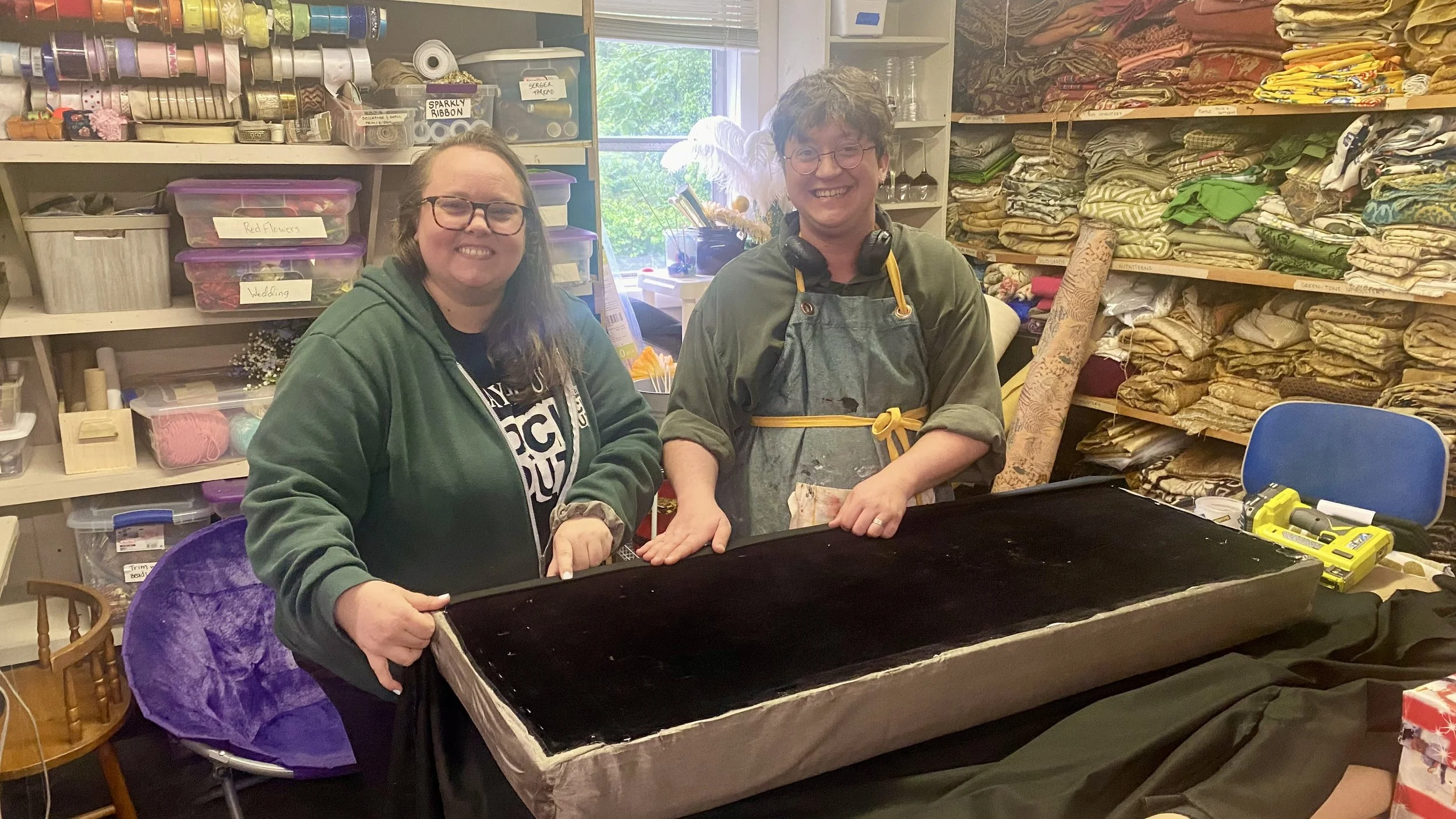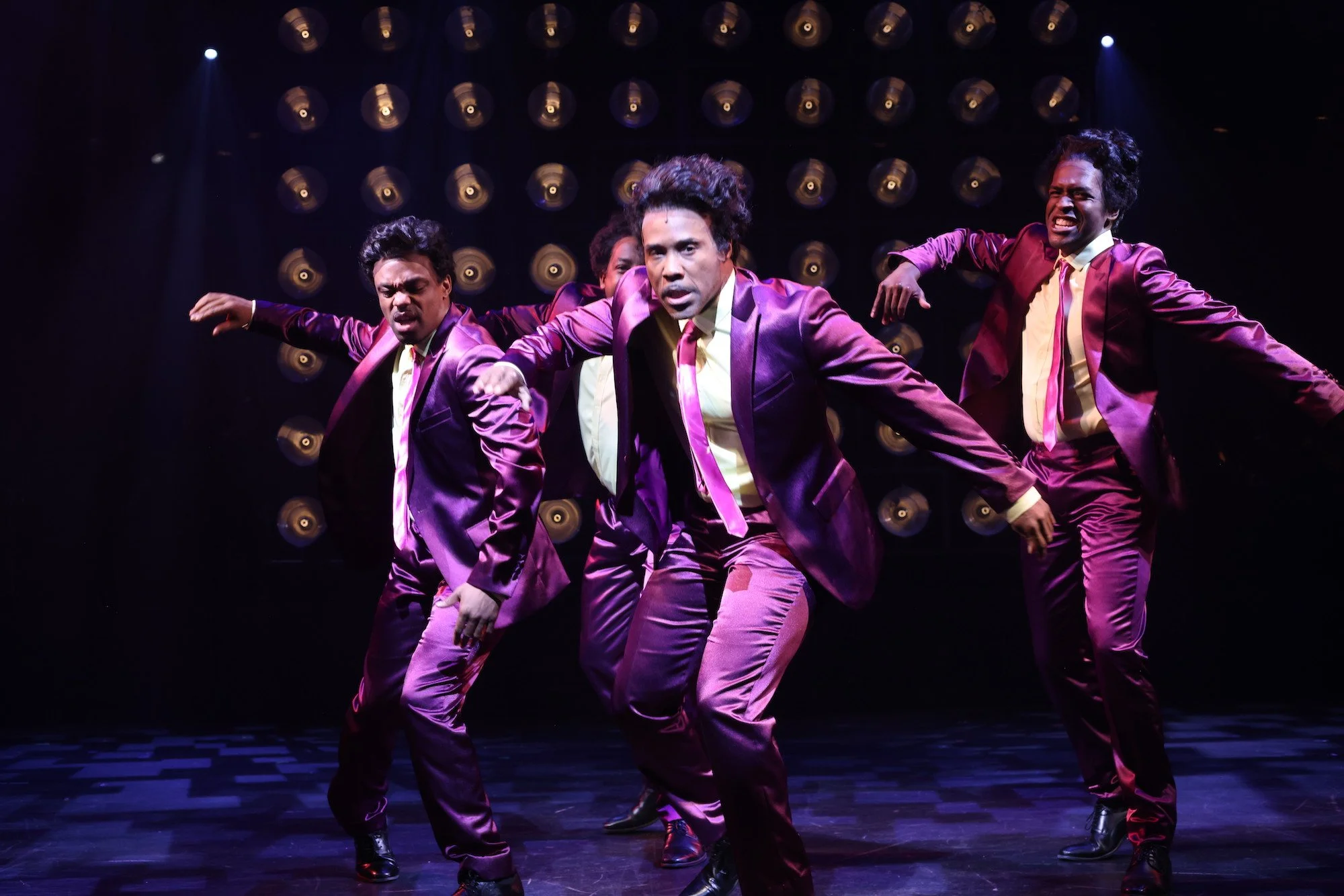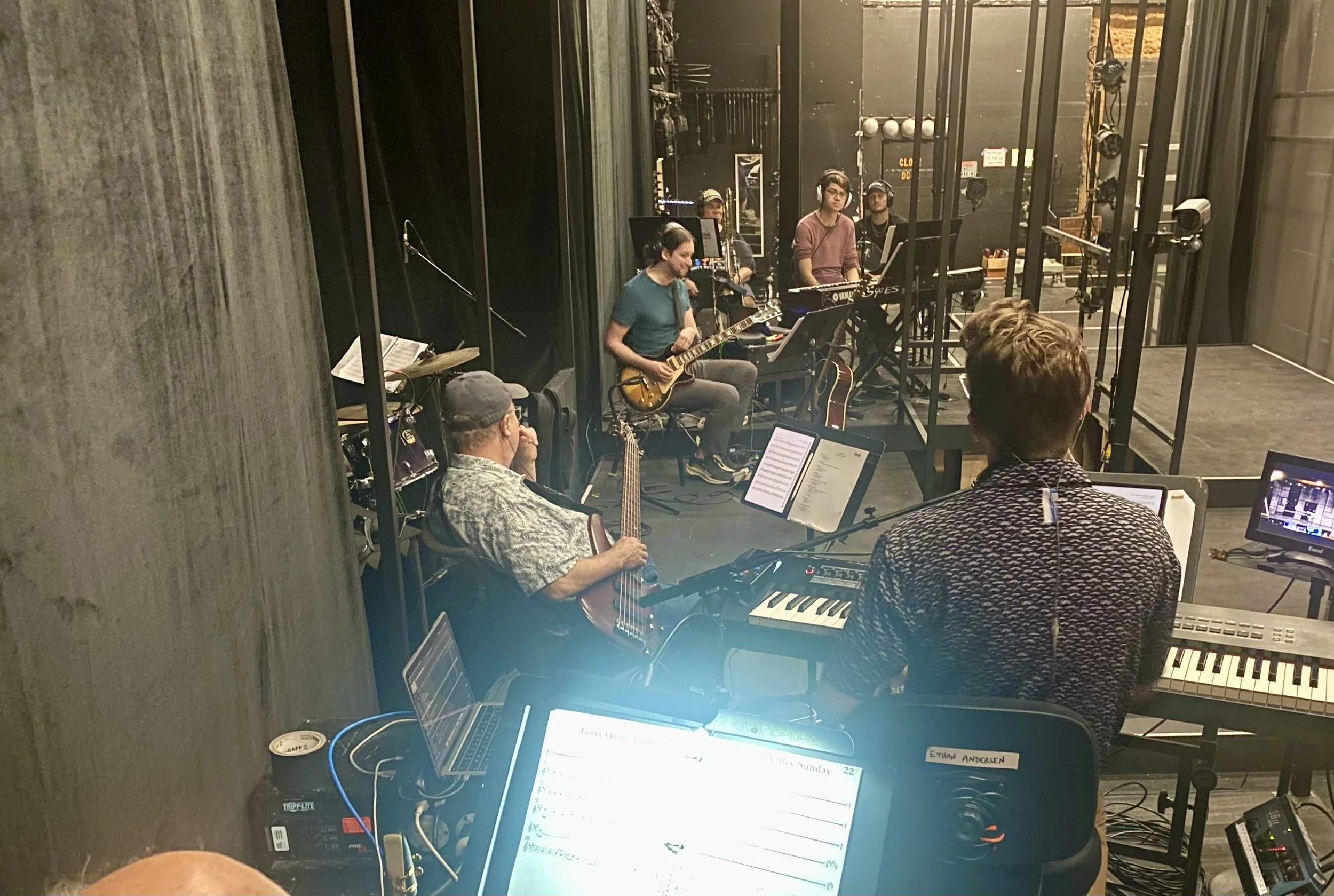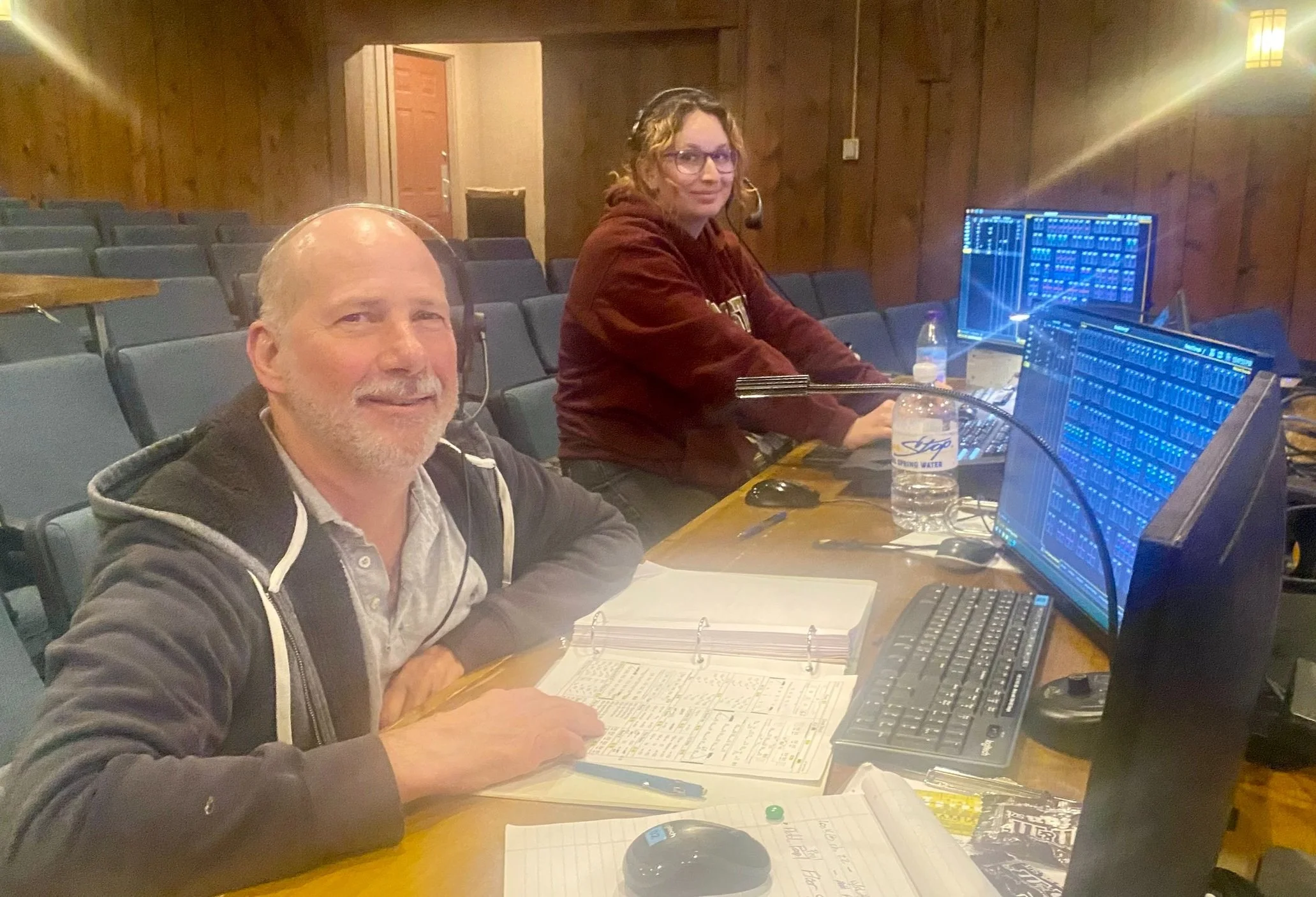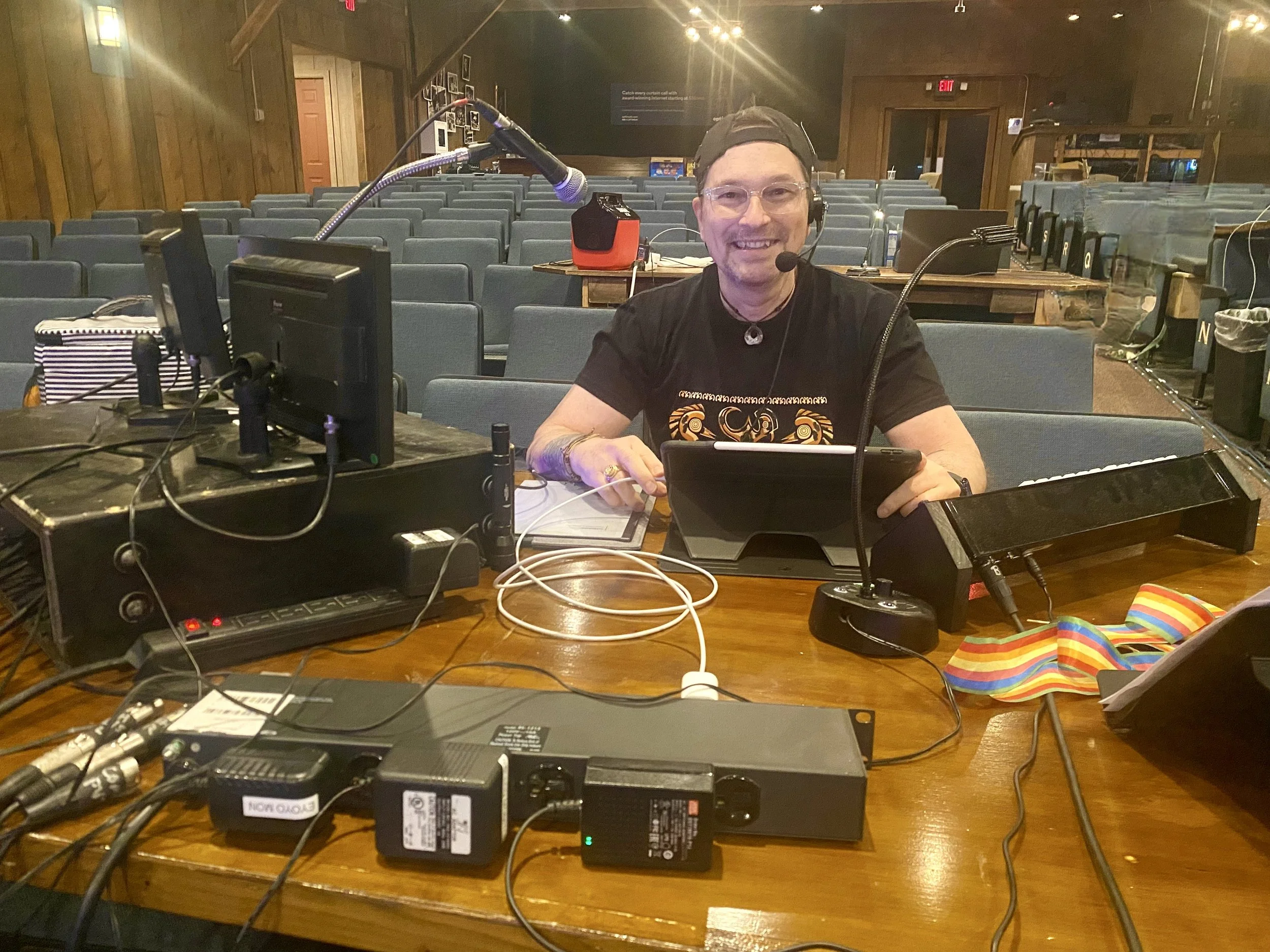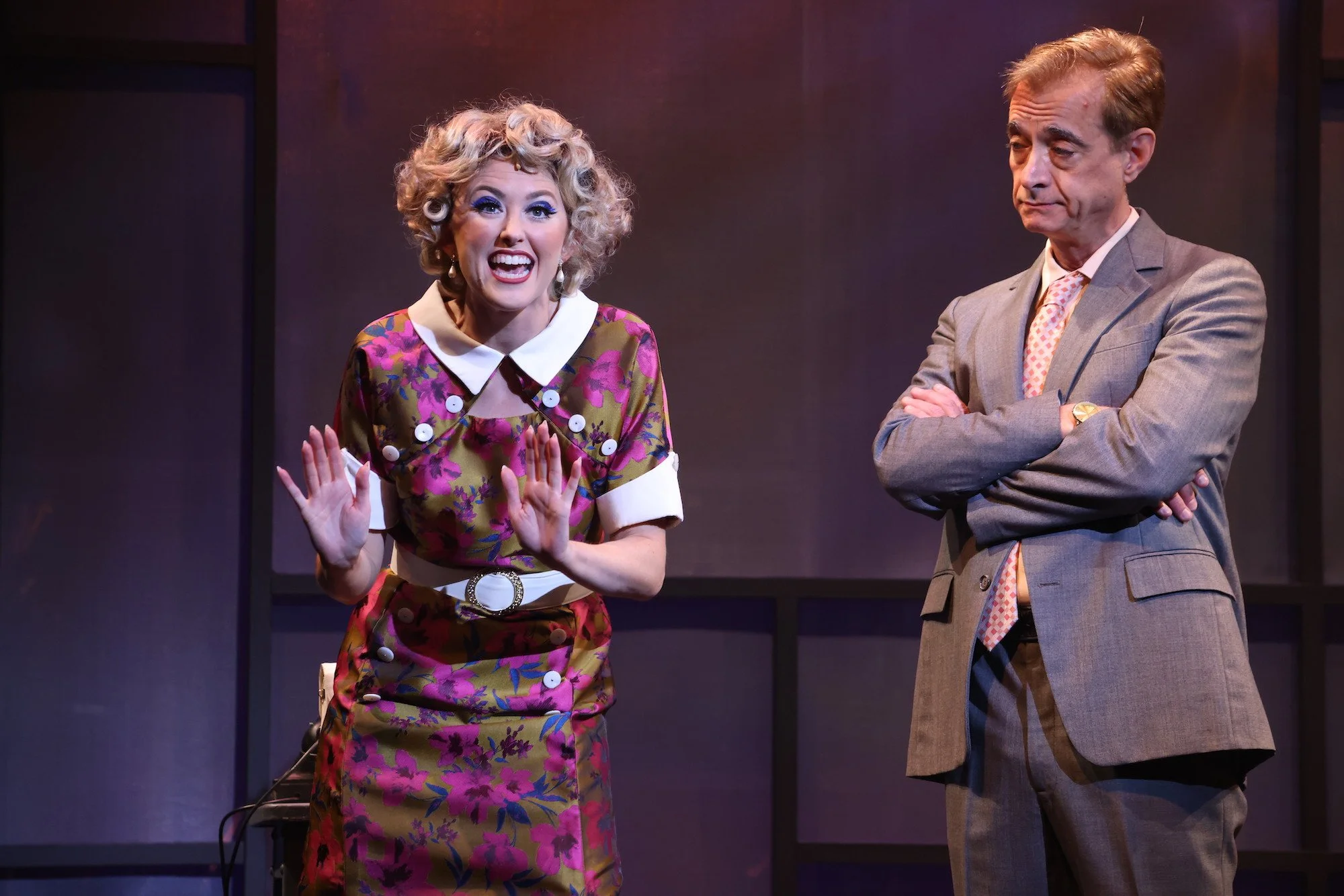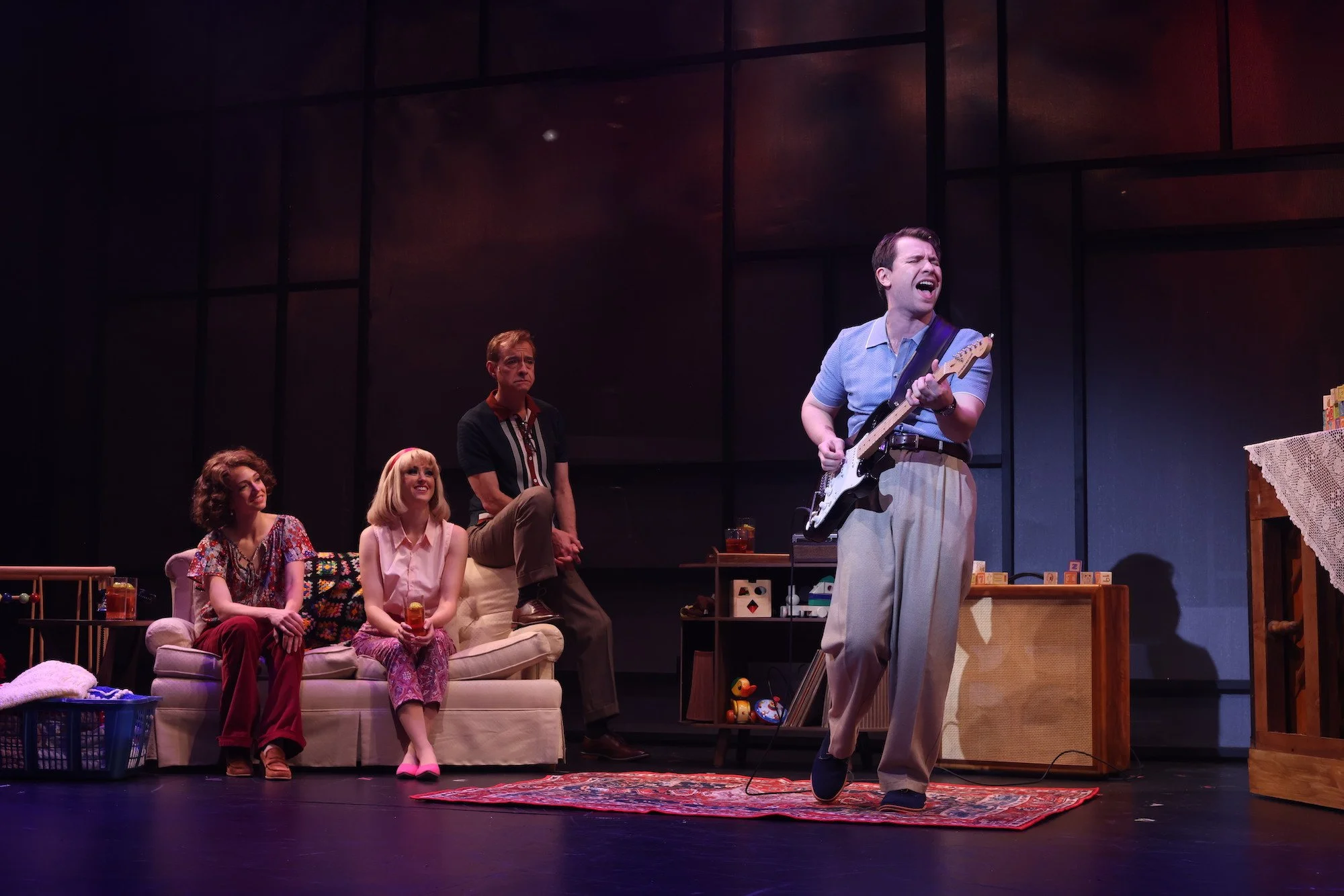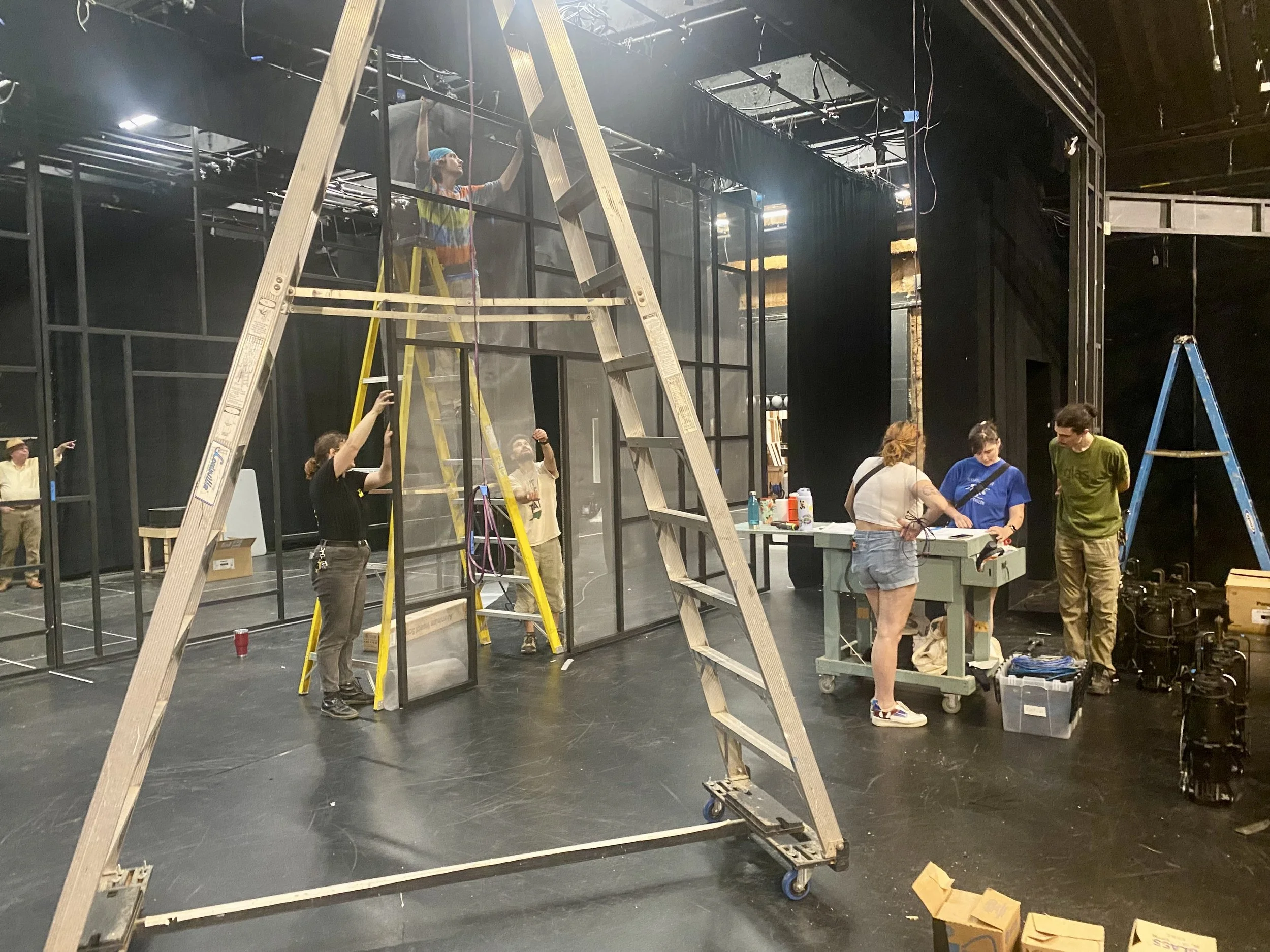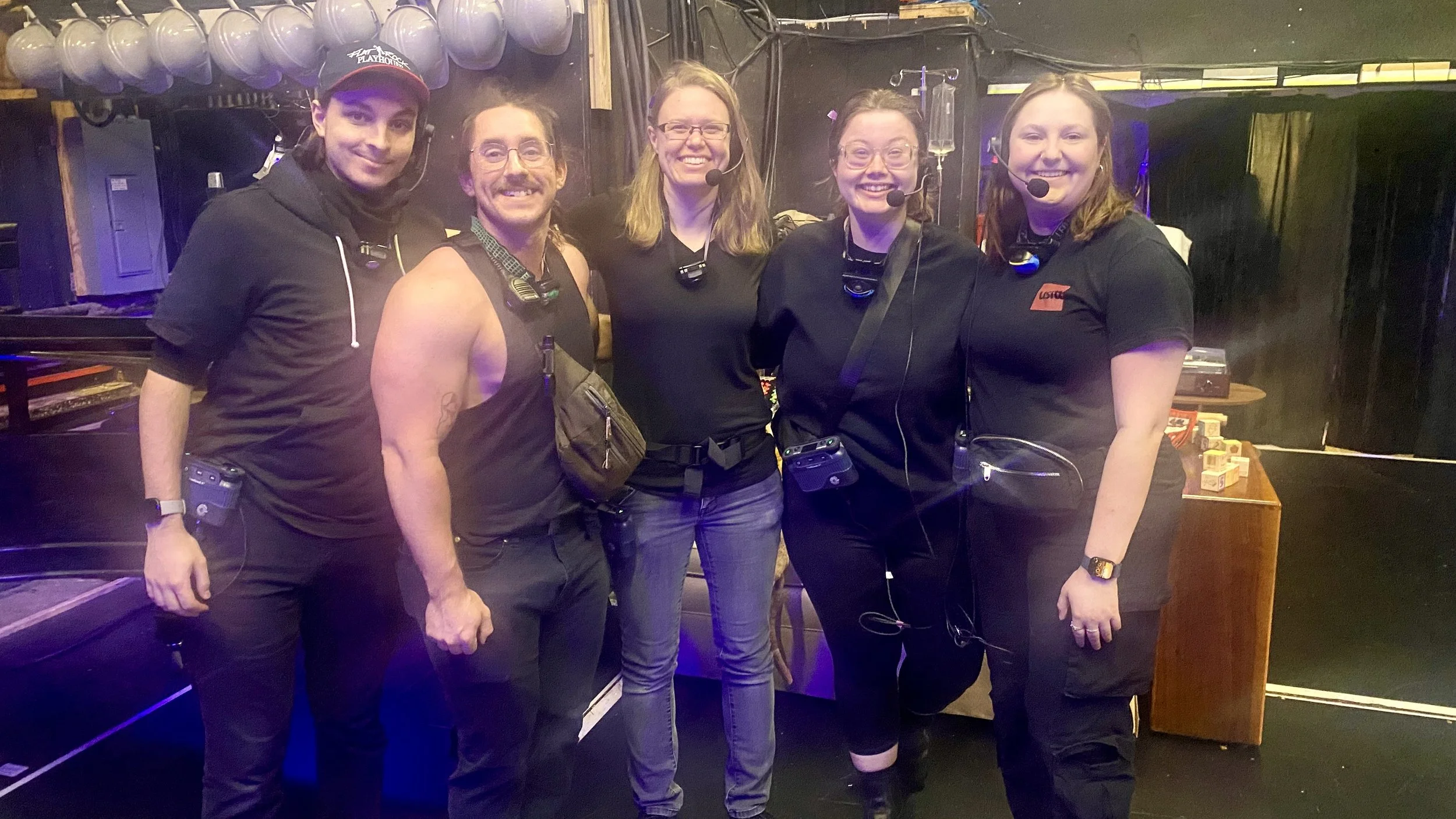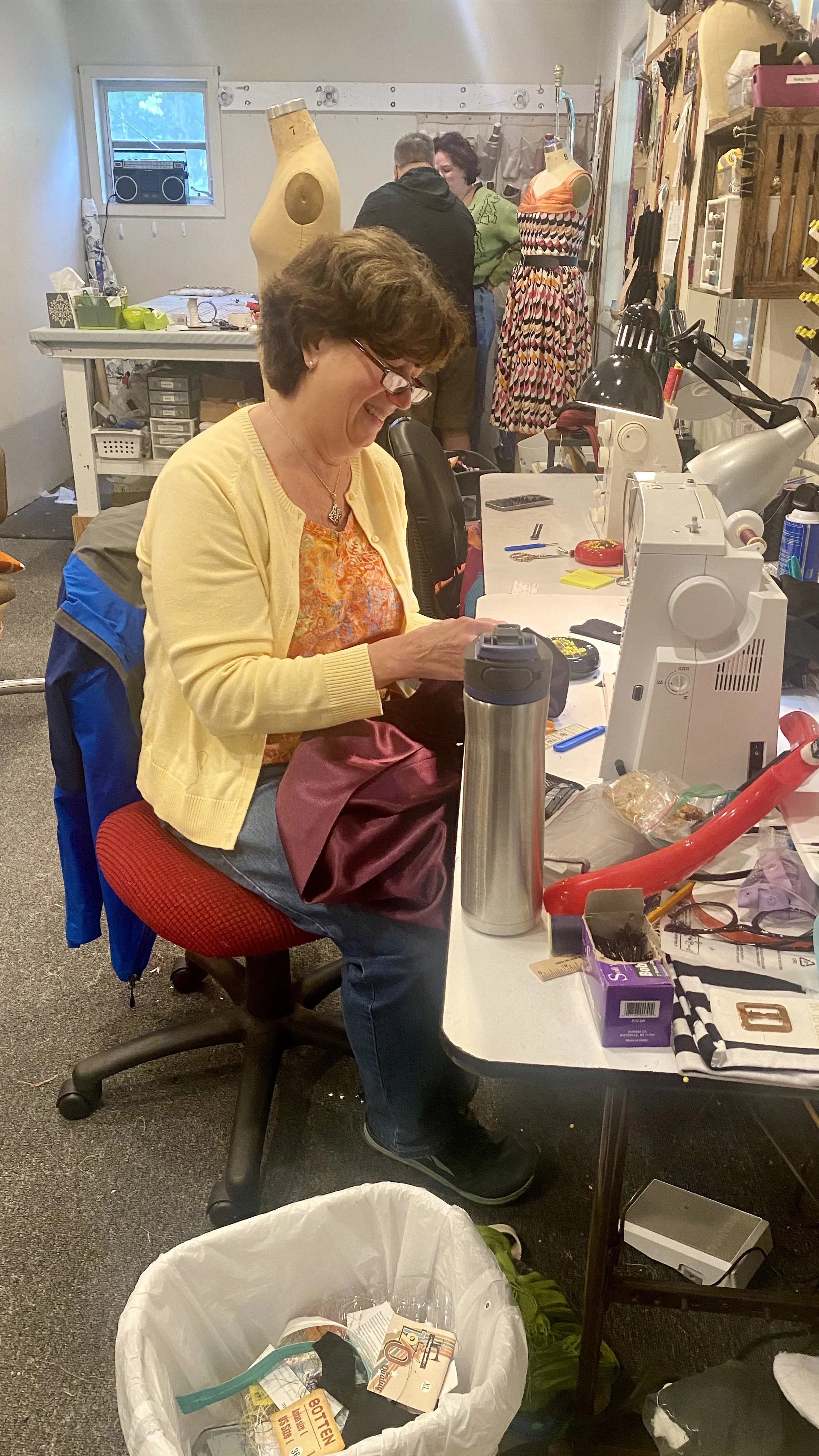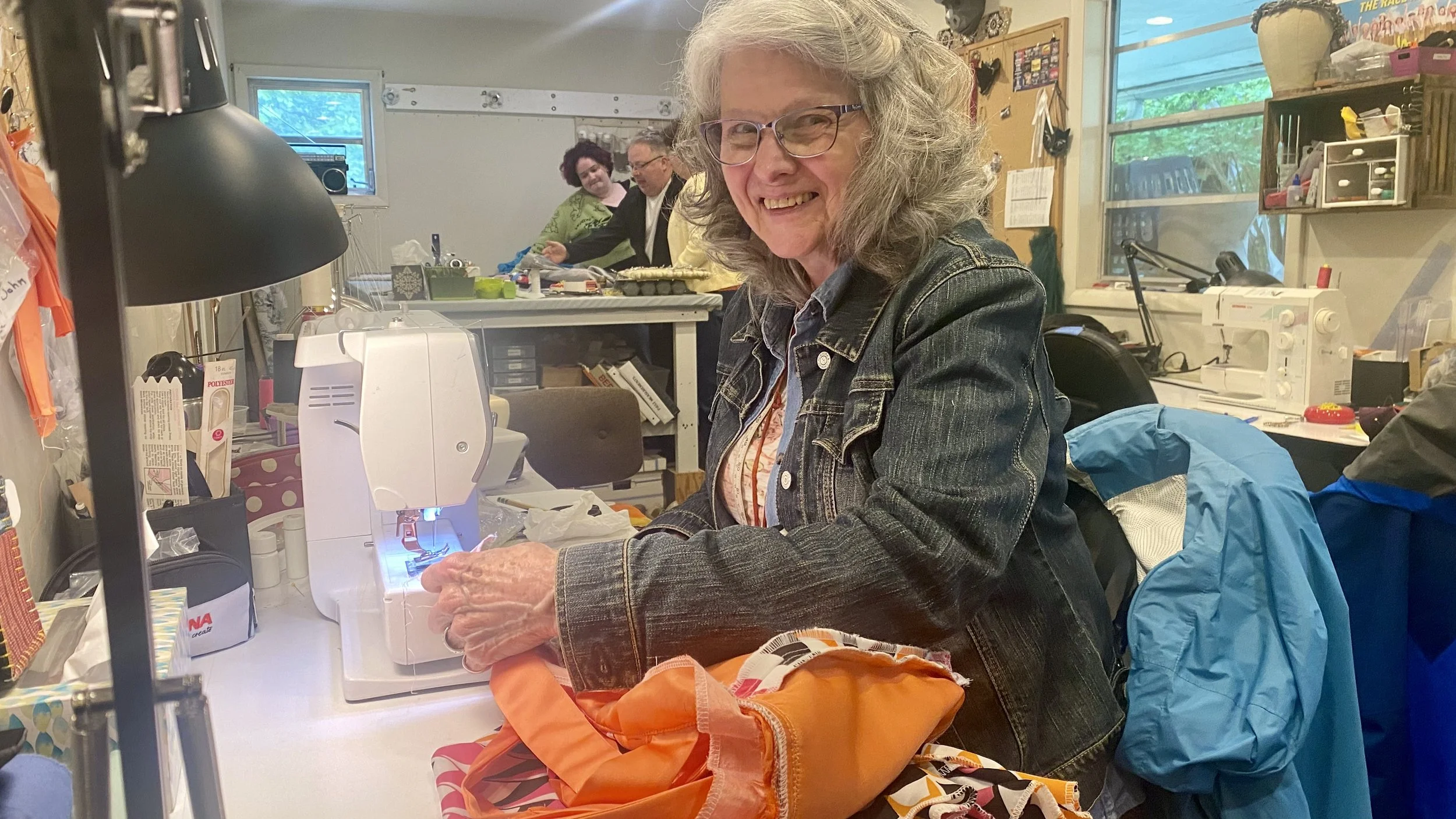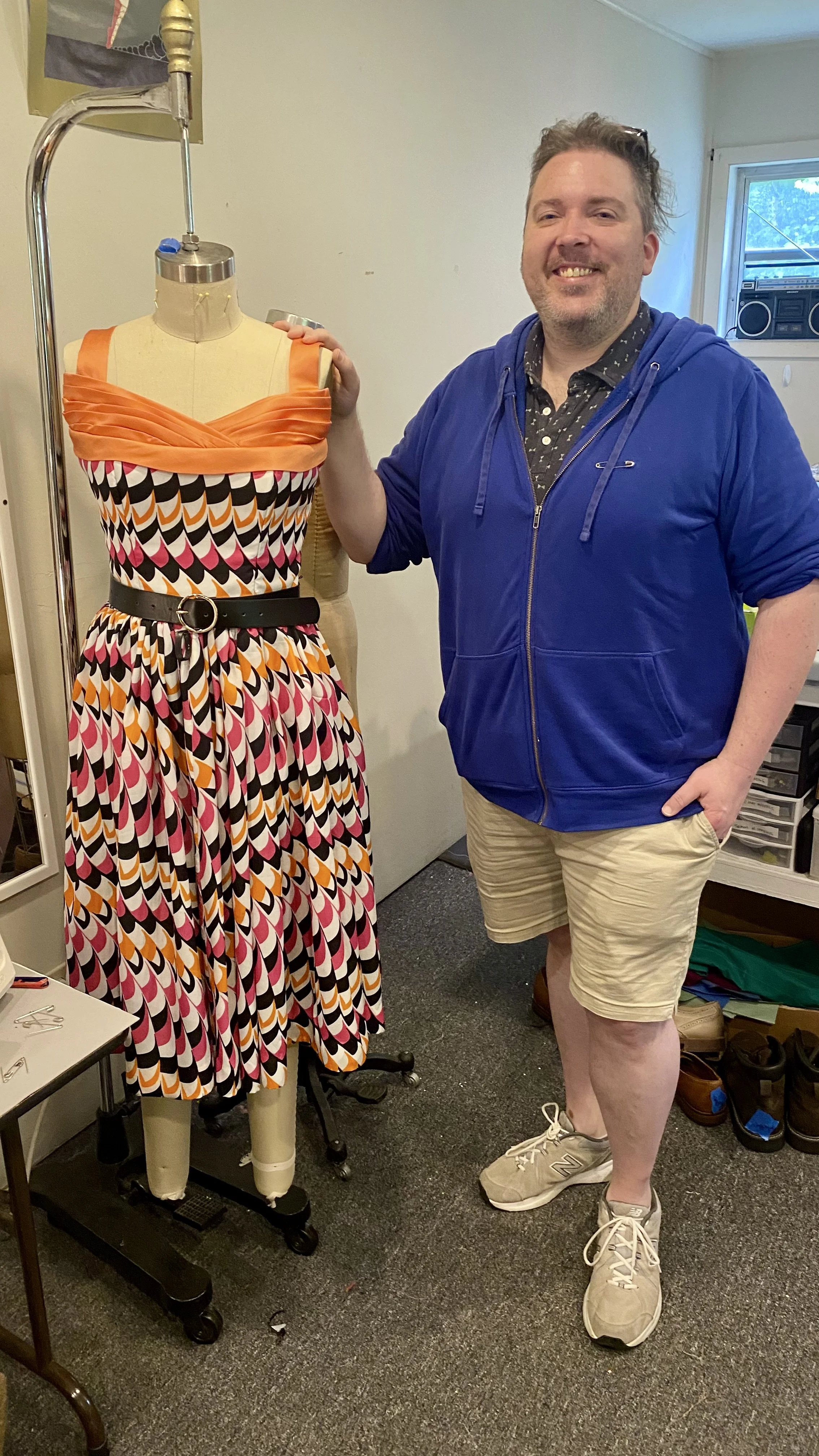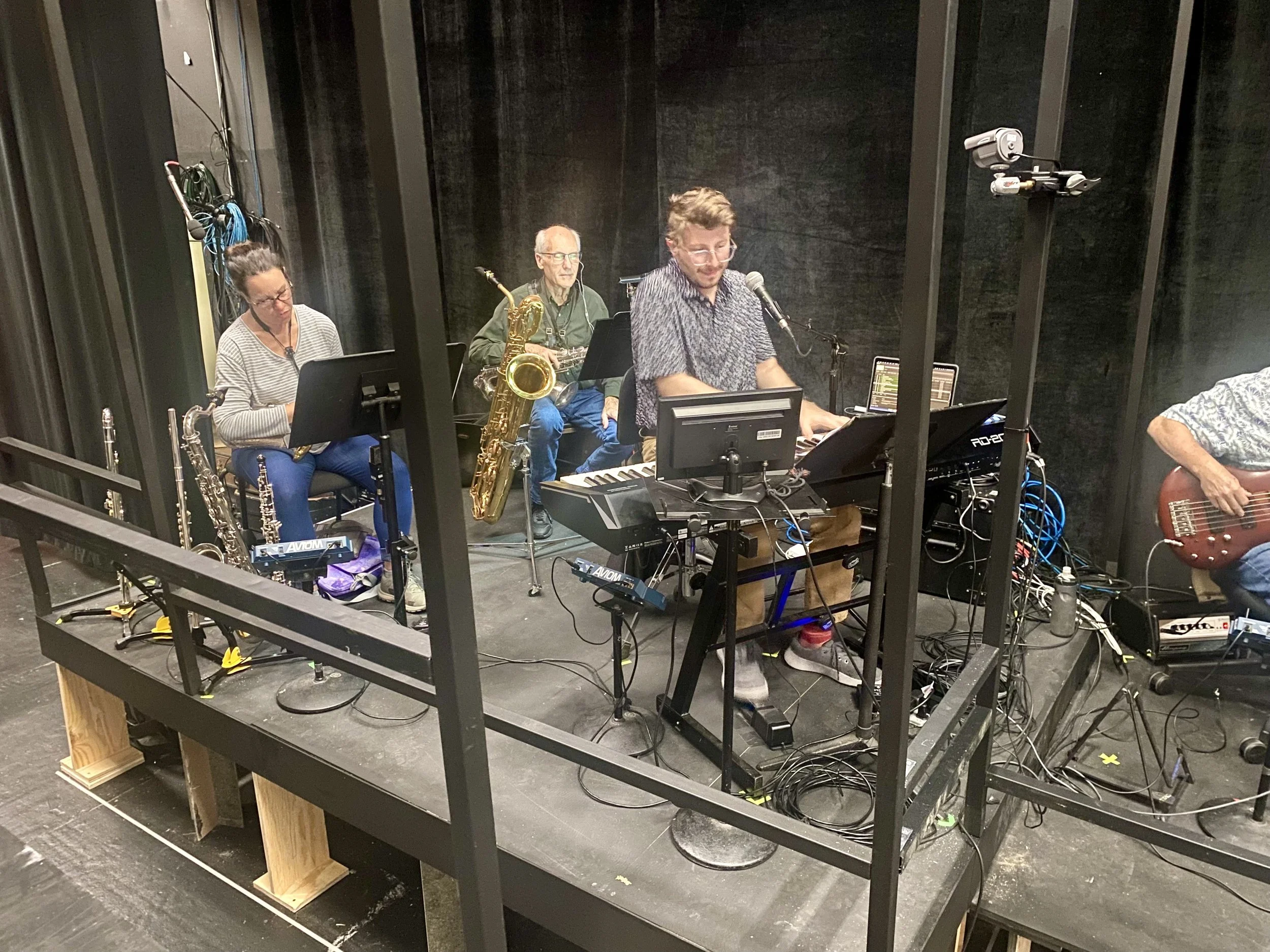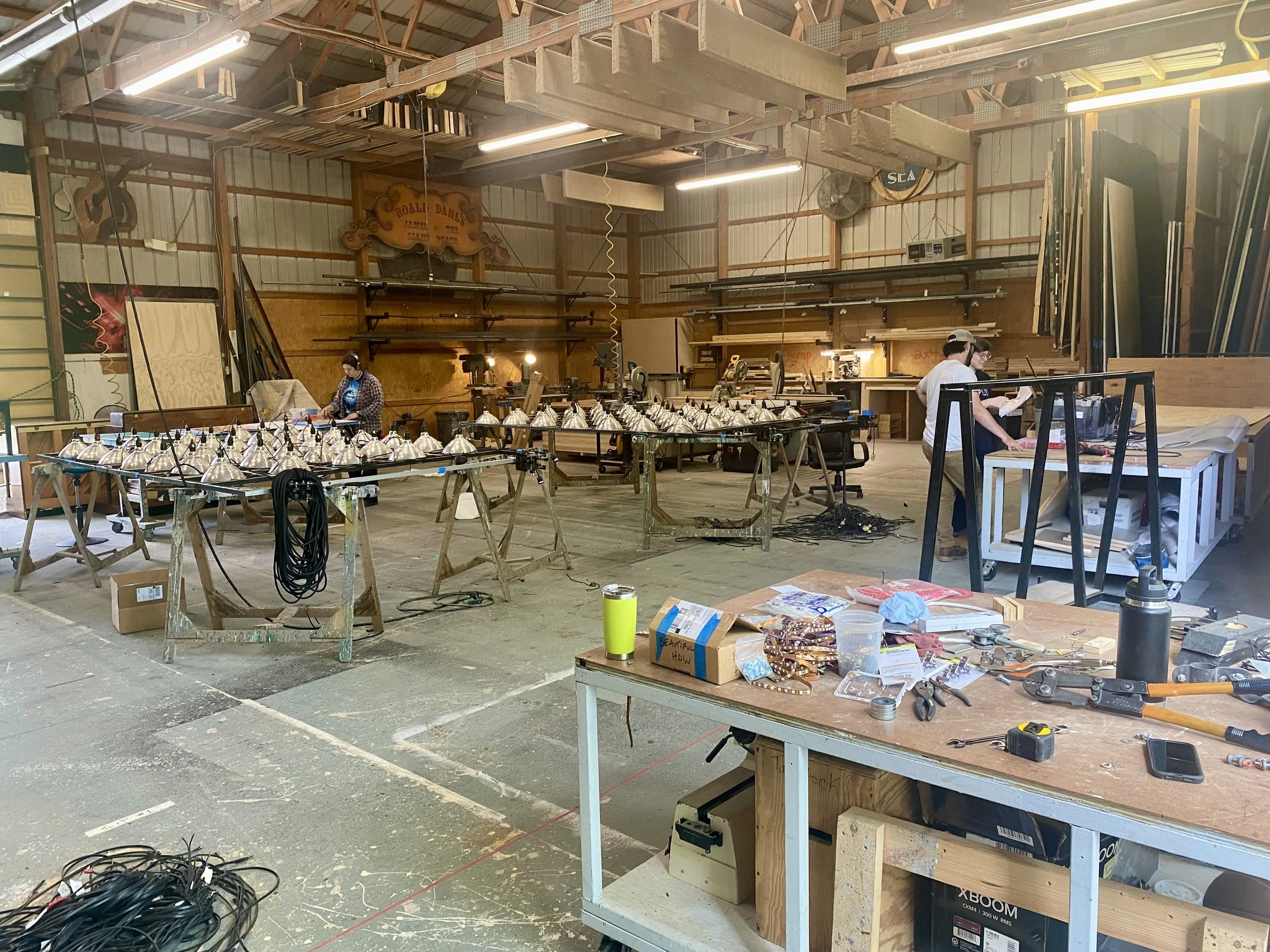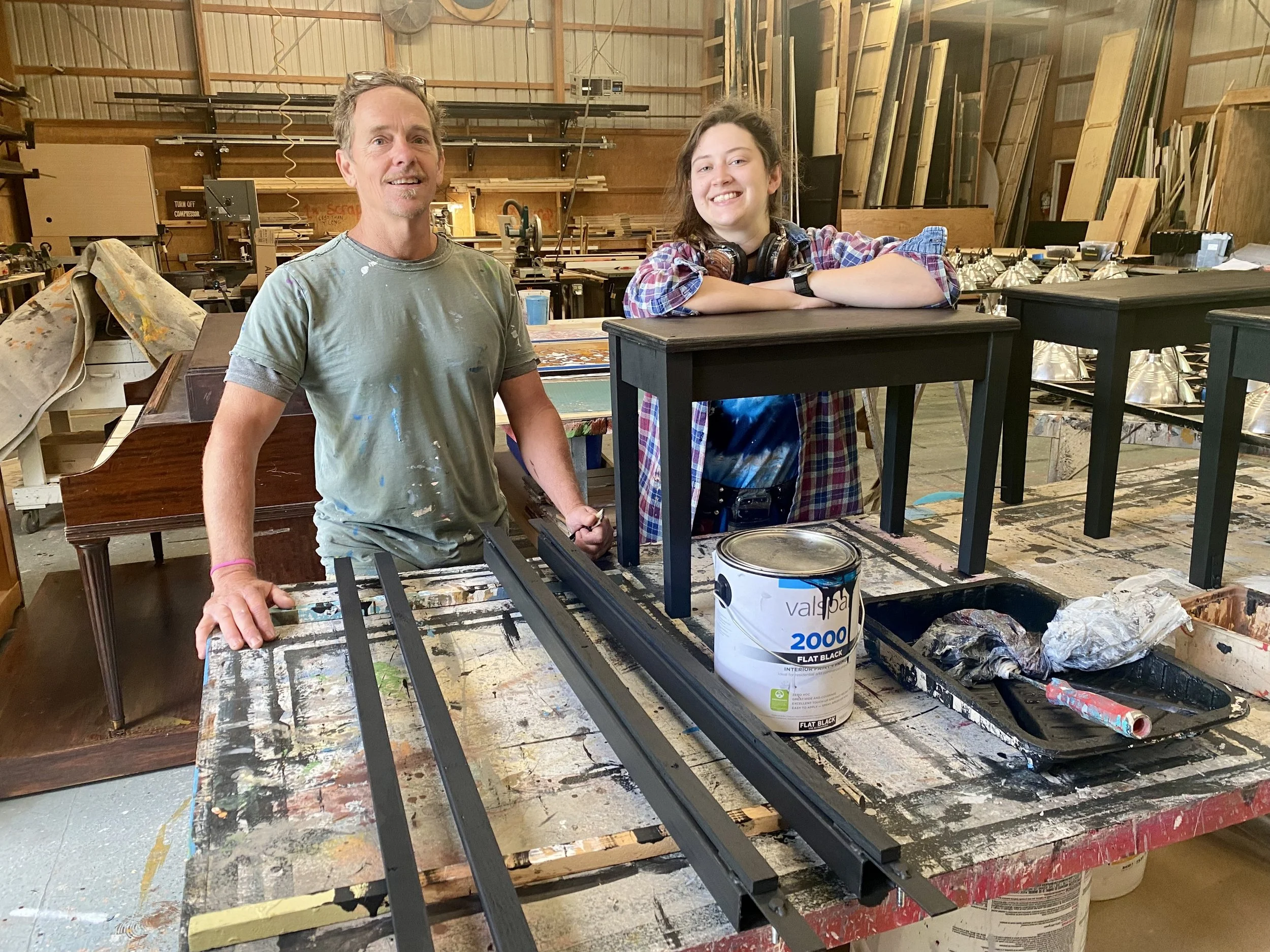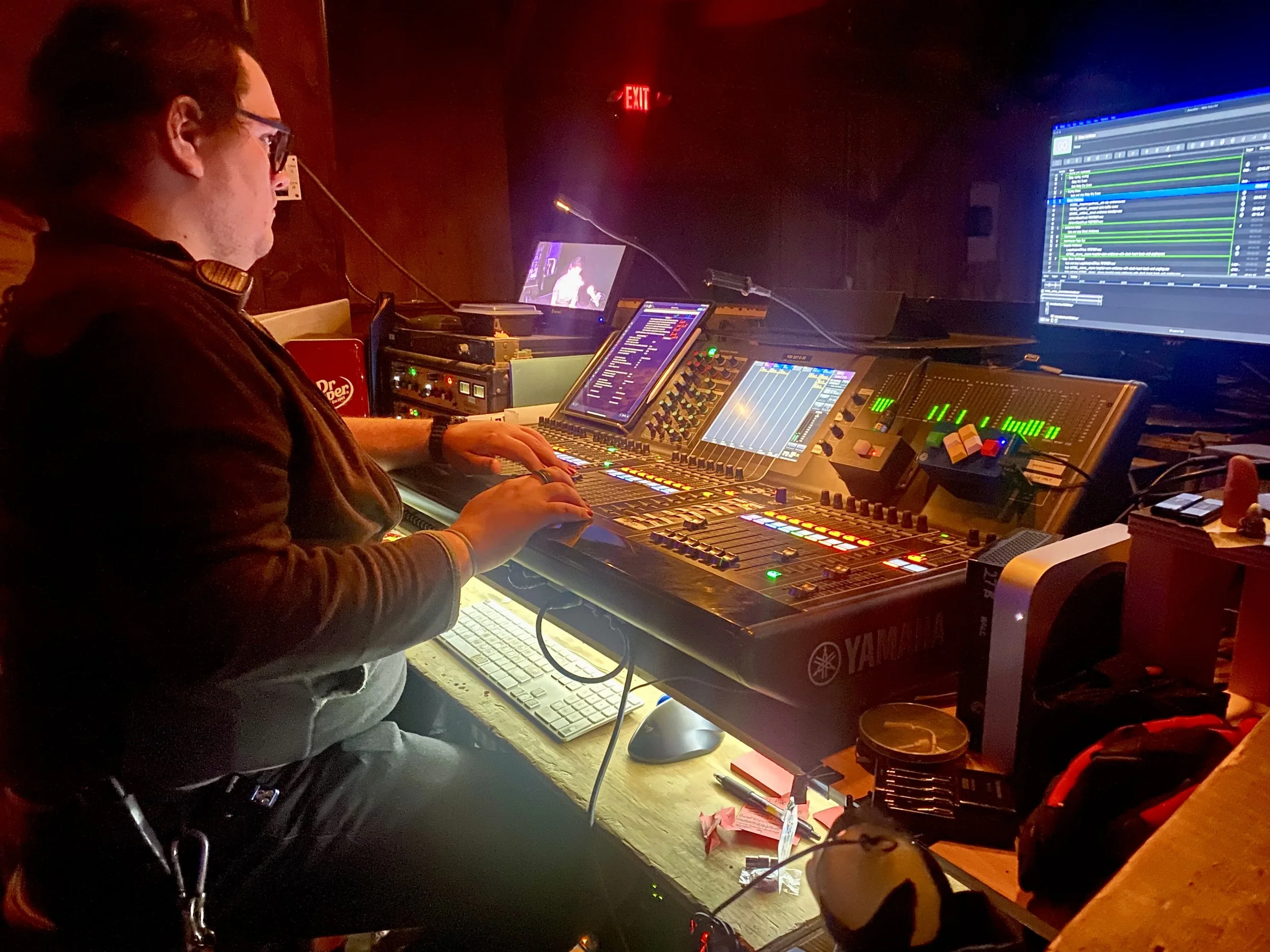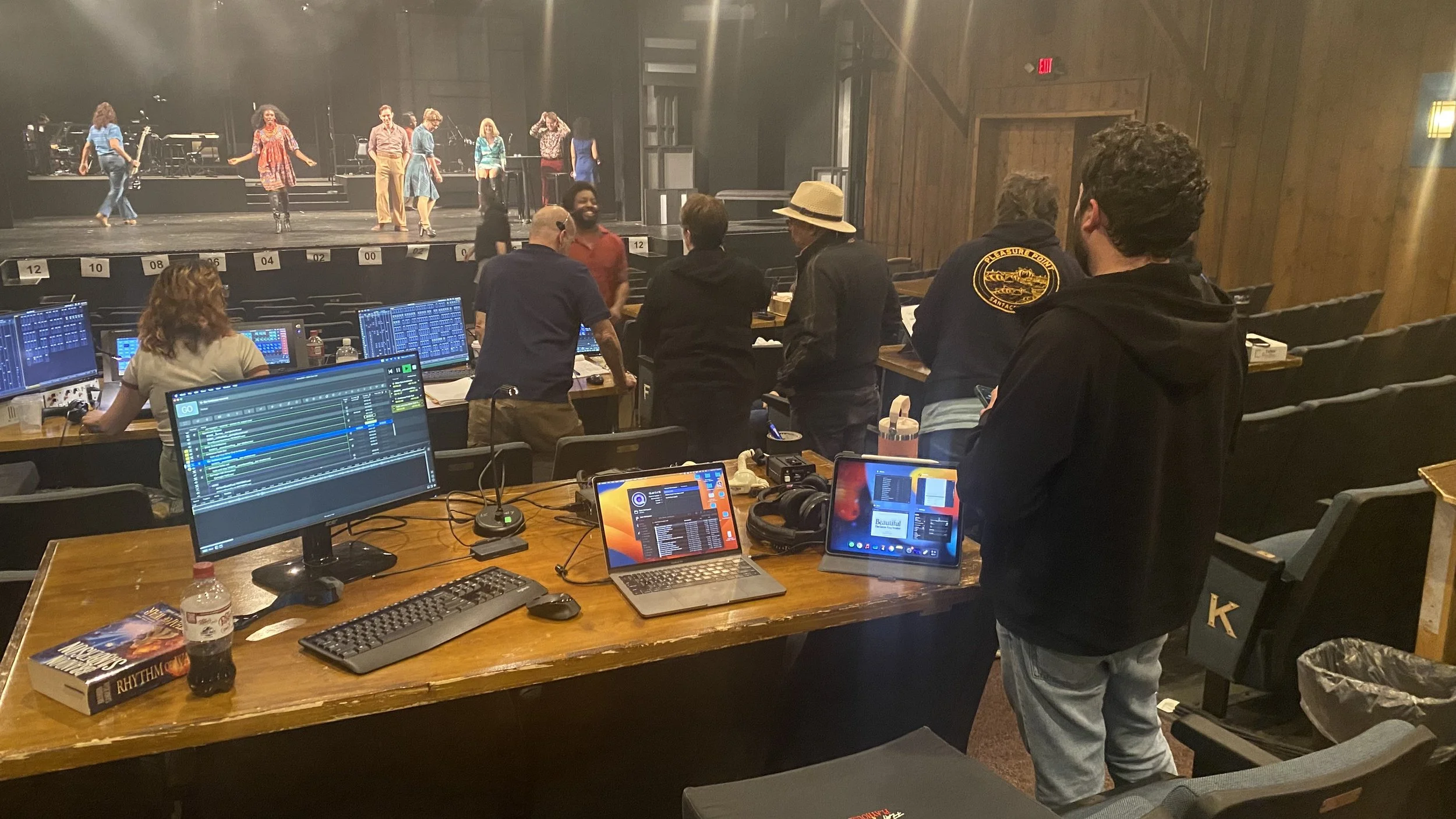A Beautiful Production
/“You’ve got to get up every morning
with a smile on your face
And show the world
all the love in your heart”
Prologue
When the final chords of Beautiful: The Carole King Musical rang out after a spectacular opening performance on Friday night, few in the audience that roared its approval could have guessed just how much went into that triumphant moment. Behind the remarkable set design, dazzling stage lights, breathtaking costumes, and soaring harmonies were months of preparation, problem-solving, creative risk, and above all, the enterprising resilience that has defined Flat Rock Playhouse for nearly 75 years.
From the initial spark of inspiration to the final sound check, this production of Beautiful was the culmination of months of tireless work by a team of artists, technicians, designers, and leaders with a vision of what is possible—many of whom rarely step into the spotlight themselves and are largely unknown to the audiences they entertain so brilliantly.
What follows is the story of how Flat Rock Playhouse has crafted one of its most exhilarating and audience-pleasing shows in its long history. It’s a story about the collaboration, exceptional artistry, and the deeply human effort that lies behind the beauty onstage.
This story is a glimpse behind the scenes at Flat Rock Playhouse.
Producing vs. Presenting Venues: The FRP Difference
Building the Set for Beautiful - Photos by Jeb Purcell
Ask FRP Producing Artistic Director, Lisa Bryant, what she wants the world to understand about Flat Rock Playhouse, and her first response will inevitably be, “We are a producing theatre. We build every show from the ground up.”
Unlike presenting venues such as the Peace Center in Greenville, which host touring productions, Flat Rock Playhouse builds every show in-house—from costumes and set design to casting actors and adapting scores for the musicians in their band. It all adds up to an enormous commitment that requires creative vision, long-range planning, logistical expertise, and a staff of artists and technicians working nearly year-round.
As a producing theatre, Flat Rock Playhouse holds a distinct artistic and educational advantage over presenting houses. Because casting, sets, costumes, music, and direction are all shaped in-house, the creative team crafts shows with a distinctive FRP signature that resonates deeply with the local community. The FRP model fosters originality, risk-taking, and a sense of artistic ownership that touring productions cannot replicate.
It also creates powerful educational opportunities: apprentices, interns, and emerging artists are immersed in the full process of theatrical creation, working side by side with seasoned professionals. Through this hands-on mentorship, they don’t just learn their craft—they live it, growing into the next generation of theatre makers. Countless artists who’ve performed and worked at FRP got their start and/or honed their skills as young artists who begin their careers in earnest at the Playhouse.
Indeed, the Playhouse mantra of “Growing Our Own” is on full display in this production of Beautiful. Among many others, Lisa Bryant, Music Director Ethan Andersen, Scenic Designer Dennis Maulden, and show Choreographer Maddie Franke all began their careers as apprentices at FRP.
From Concept to Curtain – A Timeline for Making Beautiful
Rachel Prather as Carole King in FRP’s Beautiful
September 2024: The Spark
In September of 2024, Lisa Bryant and three members of her playhouse team traveled to the Cumberland County Playhouse in Tennessee to see its production of Beautiful: The Carole King Musical.
Lisa, along with FRP Production Manager Adam Goodrum, Ethan Andersen, and Marketing Director Christy Souther, were impressed with what they saw. Traveling back to Flat Rock, the group excitedly discussed including the musical in the 2025 Playhouse season. “We just fell in love with it,” Adam recalls. “We knew our audience would eat it up—with that genre of music and Carole King’s story.”
Two days later, however, Hurricane Helene lashed the mountains of western North Carolina. Flat Rock and the surrounding region were left reeling from the catastrophic damage inflicted by the storm. So much so that the Playhouse made the difficult decision to cancel planned productions of CATS and Mountain Top, which had been scheduled for October and November. A very successful 2024 season was suddenly cut short by a completely unexpected event.
In the theatre world, however, the well-worn mantra of “The show must go on!” has been embraced by Flat Rock Playhouse for over seven decades. Even as the staff at FRP were clearing debris from their campus, waiting for the return of power to their offices, and dealing with the heartache of a truncated season, they were already planning the 2025 season.
Their focus was on the future … and the future held something Beautiful.
About Beautiful the Musical
Beautiful is a jukebox musical that chronicles the life and career of Carole King, one of the most prolific singer-songwriters of the 20th century. The musical made its Broadway debut at the Stephen Sondheim Theatre in January 2014. It ran on Broadway until October 2019, totaling 2,418 performances and becoming the 27th longest-running musical in Broadway history.
The storyline follows Carole King's journey from a teenage songwriter in Brooklyn to her rise as a solo artist with the release of her landmark album, Tapestry. The musical delves into her personal and professional relationships, particularly with her first husband and songwriting partner, Gerry Goffin, as well as fellow songwriters Barry Mann and Cynthia Weil.
The production features a rich catalog of songs written by these artists, including classics like "Will You Love Me Tomorrow," "The Loco-Motion," "You've Got a Friend," and "(You Make Me Feel Like) A Natural Woman." The show has consistently been a hit with audiences around the world.
November 2024: Planning the Path Forward
“Talkin’ ‘bout a sweet season on my mind..”
Having committed to Beautiful, the FRP team begins the long process of putting together the musical. It is still six weeks until the 2025 season will be announced, and seven months before opening night, but the wheels of producing the show have already begun to turn.
adam Goodrum, Production Manger (L) wth Joshua Stewart, Associate Production Manager, during Tech Week
Lisa’s first, and possibly most important conversation is with Production Manager, Adam Goodrum, about creating a budget for the show. “I’m imagining it (Beautiful) from the audience’s perspective,” Lisa explains. “Adam imagines the budget, the build, and what it will require from his production team.”
Budgeting
Adam immediately dives into the financial and logistical considerations for the show. He will begin the process of scheduling design meetings, calculating labor costs, sourcing materials and strategizing around one of the biggest challenges of producing Beautiful—costumes. There will be nearly 200 head-to-toe looks and well over 800 individual articles of clothing - including 17 different outfits for the actor playing Carole alone – and 105 pairs of shoes required. It is a massive and moving puzzle that must be solved – within budget – in the months ahead.
Adam also oversees the entire technical production process, including set construction, lighting, sound, props, and costumes. He sets the budgets, hires the designers (often in consultation with the director), and ensures the teams stay on track throughout the process. “I budget from top to bottom—people and materials.”
For Beautiful, Adam will assemble a mix of in-house talent and returning collaborators. Sound, props, and technical design (set build) will be handled in-house. Costumes and lighting design will be contracted for this show.
Staffing for a typical FRP production will involve 40 to 50 (including actors), which includes seven full-time department heads, and roughly 25 seasonal employees. During the frantic run-up to the show, Adam will coordinate this wide-ranging team of professionals, all toiling behind the scenes to make the 18 actors on stage look great on opening night.
The Director
“Where you lead
I will follow”
Director Amy JOnes with Ethan Andersen, Music Director and assistant Director for Beautiful
While Adam is hashing out the numbers, Lisa has to make the first and arguably the most consequential decision for the production of Beautiful – hiring the director. In this case, it was an easy decision for Lisa. She immediately reached out to Amy Jones, who lives and works in New York. “Amy has served as a musician, music director, choreographer, director, teacher, and actor,” Lisa explains. “She can do it all.” Lisa particularly values Amy’s insights and nuanced understanding she brings to Carole’s journey as a woman making her way in the music industry.
For her part, Amy is thrilled to be back “On the Rock.” “Flat Rock really became a second family for me,” says Amy. She first arrived in Flat Rock in 1998 as a performer in Swing Time Canteen. That single show sparked a decades-long relationship with the Playhouse, fostering her evolution from actor to choreographer to director. Encouraged by former Playhouse mentors like Robin Farquhar and Paige Posey, Jones grew into a leadership role in the theatre world. “They saw that I was interested in directing and musical direction,” she recalls, “and they gave me the chance to step into those roles.”
For Jones, Beautiful isn’t just a jukebox musical strung together by hits—it’s a profoundly human story of growth, resilience, and self-discovery. “Carole King’s story is incredibly inspiring,” she says. Jones is particularly drawn to King’s very relatable personal trials that shaped a body of work that resonates with millions. “Her journey is so moving, and her music is the soundtrack to that transformation.”
December 2024: Going Public
“It would be so fine to see your face at my door...”
The Playhouse 2025 season is announced on December 12th, and FRP’s marketing team, led by Christy Souther, begins the process of promoting Beautiful.
The marketing for Beautiful will promote the musical as a vibrant, must-see with highlights including a stunning performance by Broadway veteran, Rachel Prather as Carole King, dazzling costumes, high-energy choreography by Maddie Franke and Alfred Jackson, and a powerful live band made up of nationally recognized musicians. Christy’s promos promise nostalgic hits from iconic groups like The Drifters and The Shirelles, while delivering a visually and musically unforgettable experience that celebrates the legacy of one of America's most beloved songwriters.
January 2025: Creative Foundations
Adam convenes the first Creative Team Meeting with Lisa, Amy Jones, Ethan Andersen, Costume Shop Manager Tim Barham and Scenic Designer Dennis Maulden, who has been designing sets for FRP for much of the last 40 years.
Scenic Design
Scenic Designer Dennis C. Maulden with Emily Rich, Assistant Technical Director
Dennis Maulden’s long and storied relationship with Flat Rock Playhouse began in 1967, when he arrived as an apprentice after his freshman year at UNC-Chapel Hill. He returned in 1985 as scenic designer for the theater’s summer seasons, and in 2000, made Flat Rock his permanent home as the Playhouse transitioned to year-round productions. Over the decades, Dennis has become synonymous with the Playhouse’s visual identity—and his work on Beautiful is yet another standout in a remarkable career.
For Beautiful, Dennis has drawn visual and thematic inspiration from Dutch painter Piet Mondrian, using his signature gridwork and blocks of color to suggest both the architecture of New York City and the forward movement of time. The design is rooted in poetic abstraction rather than period realism, reflecting Carole King’s journey from the 1960s to the 1970s in a way that is evocative, not literal.
“I wanted something that felt graphic and modern, something that could reflect buildings, stories, and cross streets,” he said. “You can’t write a designer’s note on the set, but you hope the visual language makes the audience feel something.”
The full depth of the stage is used, with the live band visible on raised platforms—part of the action rather than tucked away. Black metal shutters, silver screening, and LED lighting create a dynamic, ever-shifting backdrop that stands in for recording studios, offices, homes, and concert halls. In place of digital projections, Dennis employs lighting to signal scene changes and emotional transitions, preserving the vintage tone of the story
Subtle metaphors run through the design, including elements of the false proscenium that echo piano keys—a tribute to King’s artistry. Numerous but minimalist props are used with poetic efficiency, allowing audiences to focus on character, story, and music.
Ultimately, Dennis’s deep emotional connection to the story—both its era and its themes of growth and resilience—infuses every detail of the set, making Beautiful as visually resonant as it is musically unforgettable.
February 2025: Finding Carole
“One fine day,
You’re going to want me for your girl”
FRP’s Audition Team in New York City. BAck row: Bear Brummel, Ethan Andersen, Dale Brown. FRont Row: Andrea Zee, Lisa Bryant, Rachel Prather.
Casting a musical as emotionally rich and musically demanding as Beautiful is no small feat—the audition process is both an art and a highly strategic undertaking. Auditions for equity actors were held in New York City over a period of 11 days in February. The process was organized by Dale Brown Casting in NYC. Dale is yet another former FRP Vagabond from the late 1980s and early 1990s, who has been a casting director for nearly 25 years and has a wealth of experience and knowledge of the actor talent pool in the NYC area.
In the audition room to greet the actors were Lisa, Ethan, and Director Amy Jones. For Lisa, the casting process begins long before actors enter the audition room. “I have a real sense of the kind of actor I want for different shows.” She also factors in housing constraints, contract requirements, and the overall shape of the season. These practicalities shape casting decisions as much as creative vision.
For Amy, she is watching for energy and personality in addition to talent. “You get a feeling about the kinds of people that are going to love it here,” she explains. This “vibe check” is essential at a theater like Flat Rock, where actors live and work closely together for extended runs.
That sense of connection became key during casting for Carole King. Lisa and Ethan both noticed the standout talent of Rachel Prather, who was originally brought in by Dale Brown as a reader—someone who assists by reading scenes opposite auditioning actors. “We really liked her energy and presence,” Lisa recalls. Eventually, Lisa checked her resume and realized Rachel had significant professional experience, including a Broadway tour of The Band’s Visit. Working through Rachel’s agent, a special audition was arranged – the last one in fact for the role of King – and the team from FRP realized they’d found their Carole. “She had an honesty that couldn’t be faked,” said Ethan. “It was like the music lived inside her.”
Dave Abrams reheARSING FOR BEAUTIFUL; Photos by Jeb Purcell
On the other side of the audition room door, the actors were impressed with their first FRP experience. Actors Conner John Gillooly and Dave Abrams both felt an immediate sense of warmth, professionalism, and support from the creative team. “You can just feel the goodness in the room,” Conner recalls. Conner had heard positive things about Flat Rock Playhouse before arriving—particularly about the people—and the experience far exceeded his expectations. “The whole rehearsal process was a gas.” Dave Abrams agrees. “I just felt supported. I knew I was with people who knew what they were doing.” Dave calls his offer from FRP a pivotal step in his career and likened the Flat Rock experience to “Disneyland for theater.”
Ultimately, casting at Flat Rock Playhouse isn’t just about assembling a group of skilled performers. It’s about building a community. Amy puts it simply: “This is a place that loves actors.” That spirit infuses every decision and creates an environment where artists thrive.
As Beautiful takes the stage on opening night, it’s clear that its incredibly talented cast isn’t just well-matched to their roles—they’re deeply connected to the Playhouse and to each other, the product of a casting process that’s as thoughtful as it is thorough.
March 2025: Locking in the Vision
By March 10th, Adam has convened the third and final Creative Team Meeting. Dennis’s Scenic Design is approved, and agreements are in place for the budget for costumes and shoes. With plans and budgets largely finalized, it is time to build the show. Meanwhile, props master Kenzie Conner begins developing the massive inventory of objects that will fill the set with life: reel-to-reel tape recorders, vinyl records, vintage microphones, a baby carriage, sheet music, and, most iconically, a rotating collection of pianos.
FRP BAnd members Misty Rondeau and Jim Anthony
Simultaneously, Ethan Andersen is reworking musical arrangements to support live performance with a nine-piece band. “There really is nothing like the energy that live music can generate in the theatre,” says Ethan. “It is like a conversation between the actors, the band, and the audience. You can’t get that energy with recorded music.”
Even as FRP Staff are planning for Beautiful, which opens on June 6th, they are also dealing with the final stages of building and opening CATS in April. With so many productions during the season coming back-to-back, there is never a time when staff at FRP are dealing with a single project. Multi-tasking is the name of the game on the Rock.
April 2025: Building Beautiful
“It’s gonna take some time this time...”
Set Construction
TEchnical Directeor Tom Willson and Assistant TD Emily rich in the FRP Scene Shop
At Flat Rock Playhouse, building a major production like Beautiful is a feat of design, coordination, and sheer muscle. That challenge was taken up by Technical Director Tom Willson and Assistant Technical Director Emily Rich, whose combined backgrounds and passion for their craft brought Dennis Maulden’s scenic vision to life—right in the midst of an already packed season.
The process of building Beautiful began in early April, even as the theater was preparing for CATS, which opened on April 25th. That meant the team had to build around live performances, adjusting their workday to accommodate quiet hours during matinees and using that time for planning or low-noise tasks. The timeline was tight: just four weeks from concept to completion in time for rehearsals with the cast.
The set design called for massive shutters—each 14 feet tall and 15 feet wide—and a clean, abstract interpretation of New York’s architecture. Much of the structure was built from steel—over 80 sticks of it—chosen for both its visual crispness and structural integrity.
Careful budgeting and strategic planning allowed the team to meet design demands while building sustainably. “We wanted to reuse as much as possible,” said Rich. “We welded only where necessary and used brackets for the rest, which means we can recover most of the steel for future shows.”
Scenic Charge, Glenn Case, handled all the painting requirements for the set design. “This set is very streamlined—minimal, sleek,” he says. “That puts a lot of emphasis on tone, sheen, and finish. The lighting team, in particular, needed the surfaces to interact well with their cues. Too much shine, and it reflects. Too little, and you lose definition.”
Despite the challenges—tight turnaround, shared space with another production, and massive components—the build came together smoothly. During Tech Week, the team addressed final safety tweaks, added kick strips to secure band equipment, and responded to small actor-driven requests like extra handles or stabilization points.
For both Willson and Rich, the emotional payoff comes not only from seeing their work on stage but from knowing the set performs as beautifully as it looks. “There’s still something magical when it all comes together—lights, sound, actors, everything,” Willson says. “And you get to be proud of how it all fits.”
Props
Kenzie Conner and Gideon Rowland in the Props Shop
For Kenzie Conner, Props Manager at FRP, building the world of Beautiful was a massive and exhilarating challenge. The show spans decades and dozens of settings—from living rooms and recording studios to television sets and concert halls—and it falls to Conner and her team to populate that world with everything from pianos and board games to cocktails, sheet music, and records.
The process for Beautiful began as early as January, months before rehearsals. Conner started by reading the script closely, identifying props explicitly mentioned and anticipating those that are implied—like a couch in a home scene or a period-appropriate lamp. Then came intensive research. “I had to dive deep into what furniture, pianos, and everyday objects looked like in the ’50s, ’60s, and ’70s.”
The scale of the show is significant. “There are so many props,” she emphasized. “Our list is at 212 items.” Among the props collected are multiple pianos—some functional, some gutted for realism. Some props, like a television used on stage, require cross-department collaboration. Lighting had to electrify it, while scenic and paint teams helped gut and modify the pianos.
Safety and durability are always top of mind for Kenzie. “If I wouldn’t hand it to a toddler, I won’t hand it to an actor,” she says with a laugh. Glass is generally avoided, and all furniture must be free of sharp edges and strong enough to endure eight shows a week.
Kenzie sees her work as both art and joyful service. “My job is basically giant-scale arts and crafts for people playing pretend,” she said. “It’s not that serious—and that’s what makes it so fun.”
May 2025: Stitching It All Together
Costumes
After CATS closed on May 18, the focus shifted entirely to Beautiful. What had been an idea, then a plan, then a design, now became a living, moving thing.
Costume DEsigner Travis Grant in the FRP Costume Shop
Designing and assembling costumes for Beautiful is an immense undertaking, one that combines artistry, logistics, and meticulous attention to detail under a compressed schedule. The show spans more than two decades of American music and fashion, with each character – and their clothing — evolving through time.
To meet that challenge, FRP contracted with costume designer Travis Grant, known for his bold period work and large-scale production experience. Joining him was the Playhouse’s Costume Shop Manager, Tim Barham, fresh off the elaborate, feline-filled build of CATS. Together, they coordinated a massive effort that involved nearly 800 individual costume pieces. “It’s not just a dress—it’s shoes, tights, wigs, accessories, everything from the skin out,” explains Tim.
Preparation for Beautiful began months in advance with initial design discussions and casting. Once actors were selected, measurements were collected—often remotely—so the team could begin sourcing and building pieces. As Tim explains, every costume is built, pulled from stock, or purchased, depending on availability, time period, and budget. “You start with: Can we pull it? If not, can we build it? And if not, can we buy it?” he says.
“It’s a time period piece, so authenticity matters,” says Travis. “But it’s also musical theatre, which means durability, speed, and magic.” That magic included quick-change garments with hidden closures, breakaway seams, and fabrics selected to show well under stage lighting.
Tim Barham, Costume Shop Manager with Alice Bryant, Assistant Costume Shop Manager
Travis relishes the challenge: “The show doesn’t allow shortcuts. Every costume has to work hard—visually, functionally, and historically. And the audience may not consciously notice each change, but they feel the period. They feel the mood.”
The compressed timeline only adds to the challenge. The team had just five weeks between CATS and the start of tech for Beautiful, forcing a fast turnaround. Fittings take place as soon as actors arrive, with adjustments often happening right up to the first dress rehearsal. “It’s an intimate dance,” Tim says. “We’re asking actors to be vulnerable and trust us to make them look and feel like their characters.”
Backstage, the work continues. Amy Povelka, the show’s Head of Wardrobe, manages nightly laundry, quick changes, and costume maintenance. Certain pieces are washed daily; others go to the dry cleaner every few days. “Some nights our team is here past midnight washing,” Tim says. “It’s a 24/7 operation.”
Despite the pressure, both Barham and Grant see opening night as the ultimate reward. “You know you’ve done your job when the audience reacts, and the actors shine,” Tim says. Travis agrees: “It’s hard work, but when the curtain goes up and everything comes together—it’s beautiful.”
Hair and Makeup
Alongside wardrobe, FRP newcomer Matthew Oliver is leading the wig and makeup effort. With 43 wigs in the show—covering nearly two decades of shifting fashion and character aging—his process is both creative and deeply methodical.
Matt Oliver, Hair and Makeup Designer
“You build a ‘wig bible,’” he explained. “Photos, styling notes, quick-change logistics. Everything has to be documented, especially when wigs are moving in and out of dressing rooms in under a minute.”
Each wig was custom-styled to reflect both period and personality: polished beehives for The Shirelles, slick pompadours for The Drifters, and natural curls for Carole’s later years. “It’s like another form of choreography,” Matthew explains. “But made of hair.”
In a production filled with iconic songs and emotional milestones, Matthew’s creations ensure that the visuals are as powerful as the music—hair by hair, memory by memory.
Cats Closes May 17th
As soon as CATS closes the lighting and sound crews jump into action. The technical team deconstructs the CATS set and begins the process of loading the Beautiful set onto Leiman Mainstage. At this point in the process, with just three weeks to opening night, the sound and lighting crews are working at full tilt as they prepare for the intensity and precision required during the upcoming process called Tech Week.
Actors Arrive May 20th
Rehearsal
First day of rehearsal of the cast of Beautiful
Amy Jones has poured her heart into this production at Flat Rock Playhouse, and it shows in the chemistry, camaraderie, and commitment of the cast she helped assemble.
Creating a production like Beautiful requires more than hitting marks and learning harmonies. For Amy, the real work begins with building a space where vulnerability and collaboration are not only encouraged but essential. “We’re telling a story about someone finding her voice,” Amy says. “That means every actor has to bring their whole self into the room. And they have.”
Rachel Prather, who plays Carole King, instantly developed a connection with the creative team and appreciates Amy’s directing style. “Amy gives you room to explore. She’s thoughtful and collaborative, and she really trusts her actors. That means everything.”
That sentiment is echoed by Alfred Jackson, who plays a member of The Drifters and also serves as Associate Choreographer. “The energy in the room has been electric since day one,” he says. “Amy sets the tone. She’s kind, but she’s also clear and focused. We’re telling a story about real people and real struggles. You can’t fake that—you have to feel it.”
Maddie Franke, Choreographer for Beautiful
Flat Rock’s unique environment only strengthens the connection among cast and crew. “Being here is like summer camp for adult artists,” Prather jokes. “The beauty of the area, the calm—it's the perfect contrast to the intensity of the material.”
Amy Jones agrees. “When you leave rehearsal and step into this natural beauty, it feeds your spirit,” she says. “Then you come back to the work refreshed. That’s rare. It’s why I keep coming back.”
The story of Beautiful is about music, yes—but under Amy Jones’ direction, it’s also about the power of people working together with purpose, care, and courage. That harmony, more than any chord, is what lingers when the final notes fade.
—
Choreography
“I feel the earth move under my feet ...”
When Beautiful hits the stage at Flat Rock Playhouse, audiences will not only hear the familiar songs of an American music icon—they’ll also see them, expressed through movement that pulses with authenticity, heart, and theatrical flair. Behind every groove, glide, and group number are co-choreographers Maddie Franke and Alfred Jackson, whose creative partnership brings the era and energy of Carole King’s world to vivid life.
For both Franke and Jackson, working on Beautiful is more than just a job—it’s a personal milestone. Jackson, a veteran performer and NAACP Award-winning choreographer from South Central Los Angeles, has worked internationally in productions ranging from RENT to Dreamgirls to Michael Jackson’s Man in the Mirror. He’s no stranger to Flat Rock Playhouse either, having first performed here in 2011. “Flat Rock is family,” he says. “Whenever I can be here, I’m here.”
Franke’s journey with Flat Rock began in 2008 as a young apprentice, and over the years, she’s grown into a multi-hyphenate artist: performer, teacher, marketer—and now, main stage choreographer. “This is my favorite place on Earth,” Franke says. “It’s home. To choreograph a show here with Alfred and Amy—it’s a dream.”
Their process was rooted in mutual respect, creativity, and lots of shared homework. “We started conceptualizing in January,” Franke says. “Then in February and March, I was on my feet with dancers, working things out. Alfred was doing the same—watching vintage videos, recording ideas, building movement that feels true to the time.”
“You don’t want to over-choreograph something like ‘The Locomotion,’” Franke explains. “But for theater, we have to heighten it, give it more visual pop while staying true to the spirit of the time.”
Alfred Jackson (center), Associate Choreographer. Performing as one of the Drifters in Beautiful
Jackson adds, “Groups like The Drifters and The Shirelles—there was simplicity and elegance in their movement. It oozed style. We wanted to honor that without making it feel dated.”
Unusually, both choreographers are also in the cast—Maddie as Marilyn and Alfred as one of The Drifters. That dual role sharpened their awareness of spacing, transitions, and physical demands. “You think differently when you're one of the bodies on stage,” Franke says. “You understand flow better, and it makes you more empathetic to the cast’s needs.”
Jackson reflects, “People think they know the story of Carole King. But this show gives you the music and the behind-the-scenes heartbeat that made it all possible. That’s what Maddie and I tried to show through the movement. The heartbeat of an era.”
If opening night’s thunderous standing ovation is any indication, that heartbeat is coming through loud and clear—and dancing all the way into the hearts of those lucky enough to see Beautiful unfold onstage.
May 30 - The Band Comes Together
“Jazzman, take my blues away...”
As Music Director for Beautiful, Ethan Andersen is overseeing the largest live orchestra the Playhouse has assembled for a musical since before the pandemic: nine musicians on stage, including a full brass section. “We’re almost matching the Broadway orchestration. I only had to omit two instruments. That’s rare.”
BEautiful Band during Rehearsal
Re-orchestrating such iconic music is no small task. “These songs are sacred,” he says. “You don’t want to mess with what people know and love. But I do rework the score so that each of our nine musicians is covering the essential parts.” The result: tight harmonies, bold brass lines, and a rich, full sound that promises to thrill.
Among the standout musicians are percussionist Paul Babelay and guitarist Ryan Guerra, both of whom will be visible on stage and even integrated into the action. “We love when we can be seen,” Andersen says. “People often assume our music is prerecorded. Seeing it live adds a whole new energy.”
Andersen's official title—Artistic Associate and Music Supervisor—reflects his growing role at Flat Rock Playhouse. This season, he’s also stepping into the world of direction, assisting Jones on Beautiful and preparing to direct the Playhouse’s upcoming Christmas production. “It’s been like a masterclass,” he says of working alongside and learning from Amy Jones.
June 2–5, 2025: Tech Week — Controlled Chaos
Sound
Kurt davis, Sound Designer (L) with Sound Board Operator, Mason Sams
Kurt Davis—FRP Head of Audio and the Sound Designer for Beautiful—has crafted a dynamic and emotionally resonant sound design that supports both the storytelling and the familiar musical repertoire. With a background in theatrical design and years of hands-on experience, Davis brings both technical precision and artistic sensitivity to this jukebox musical.
The production utilizes approximately 40 individual mic inputs, including wireless microphones for every principal actor, and a range of strategically placed mics for the live band. The audio team works in tandem to ensure seamless execution. Mason Sams, at the mixing console, actively manages vocal levels and musical balance, while Kaden James handles backstage mic logistics and quick swaps. Together, they ensure that every lyric, harmony, and spoken word is crystal clear to the audience, contributing to the show’s emotional impact and musical authenticity.
Davis's design philosophy is rooted in creating an immersive soundscape that feels both intimate and grand. For example, when Carole begins a song alone at the piano, the mix starts soft and personal—then gradually builds into a full band sound as the scene transitions, evoking the transformation from songwriter to pop sensation. These transitions are technically supported through digital consoles and scene programming, allowing for real-time adjustments and precision control over which mics are live at any given moment.
Davis’s work on Beautiful exemplifies how sound design, when done right, elevates the experience without drawing attention to itself—leaving the audience remembering the performance, not the technology behind it.
Lighting
Lighting Designer Todd Wren with Georgia Fenimore, Production electrician
Watching Beautiful, audiences will find themselves swept through a decade-spanning journey of pop music history, heartbreak, and transformation. The story unfolds through song and performance—but the emotional tone, the seamless transitions, and the atmosphere of each moment are shaped profoundly by the invisible hand of lighting designer Todd Wrenn.
Todd describes Beautiful as “cinematic” in structure. Act One alone features more than 20 scenes, many less than a page in length. That constant flow demands lighting that can move fluidly and quickly—helping the audience track emotional shifts and physical location changes from one moment to the next. “Sometimes we dissolve from an office scene into a concert number, then out again in just a few minutes,” he says. “Lighting becomes the glue that binds it all together.”
Todd has an impressive toolkit at his disposal, including:
125–150 conventional (incandescent) lights
60 LED fixtures
11 moving lights
20 color scrollers (devices that shift color gels over lights dynamically)
In total, around 180 individual lighting fixtures help tell Carole King’s story.
But despite the technological advances of recent years, Todd is firm in his philosophy: “The technology can’t overpower the story. It’s just the brush—the artistry comes first.” That artistry reveals itself in how Todd sculpts space, time, and emotion. Light can create mood, define place, shape a performer’s body in space, and subtly guide the audience’s attention.
—
Production Stage Manager
The Captain of the Ship
Bill Muñoz, Production Stage Manager
While audiences at Flat Rock Playhouse are swept away by the emotional journey and iconic music of Beautiful, an essential figure remains out of sight—yet his impact is felt in every light and sound cue, scene change, and beat of the performance. That person is Billy Muñoz the show’s Production Stage Manager, a role that blends precision, stamina, and leadership in one seamless act of coordination.
Muñoz’s connection to Flat Rock Playhouse runs deep. He first arrived as an apprentice in 1985, and over the years has served as actor, stage manager, production manager, fight choreographer, and educator. From 1994 to 2012, he worked full-time, managing some of the theater’s most ambitious productions. In 2015, Artistic Director Lisa K. Bryant brought him back into the fold, and he now stage-manages all major Equity shows.
Tech Week is where Muñoz’s role comes sharply into focus. As cast and crew run scenes with full lighting, sound, set changes, and costumes for the first time, Muñoz is the one orchestrating the behind-the-scenes symphony. “I make sure that everything is flowing well,” he says. “That includes calling cues for lights, sound effects, and scenic elements—any change the audience sees or hears during the performance.”
Beautiful is no small undertaking. With more than 400 individual cues per show, Muñoz juggles lighting transitions, scenic movements, spotlights, and sound effects—all precisely timed with live performance. “This one is as busy as West Side Story,” he notes, referencing another technically demanding production. “There are a lot of moving parts, and I have to stay completely locked in.”
Once Beautiful officially opens, Muñoz assumes full command of the production for the duration of its run. “It’s like being the captain of a ship,” he says. “The designers and directors hand it over to me after opening, and then it’s my job to maintain the integrity of their vision.”
June 6th: Opening Night
“A wonderous woven magic in bits of blue and gold
A tapestry to feel and see, impossible to hold.”
As the show opens, there is a mixture of excitement and some nerves for the people who’ve spent months leading up to this moment. The final rehearsal is behind them, the costumes are pressed, and the stage lights are set. Now all that remains is the thrill and unpredictability before a live audience. For everyone involved, from the actors on stage to the crew backstage, Opening Night is both a culmination and a beginning.
Emily Grace Tucker and Scott Treadway in Beautiful
Adam Goodrum is working through a full spectrum of emotions. “I’m excited, nervous, worried, relieved,” he admits. “I know where the kinks are. I know where the sharp turns are. I know where things could go wrong, so I’m on the edge of my seat for each of those moments and it’s either ‘whew’ or I’ll make a note.” His words capture the blend of exhilaration and hyper-awareness that comes when months of preparation are suddenly real and performed before an audience.
For Dennis Maulden, Opening Night taps into something even deeper. “I cry at card tricks,” he says with a laugh. “But sharing an audience with all the people who are working towards the same goal makes me feel really positive about what I do and about our industry. I love that there are so many people who feel the same way about theater that I do and share this journey with me.” His sentiment is a reminder that behind the glamour and applause is a community bound by passion, persistence, and the magic of telling stories together.
And the audience?
They are swept away. I am swept away. From the moment the curtain rises, we are immersed in a world shaped by the Flat Rock Playhouse team’s extraordinary craftsmanship—every detail from set design to lighting, sound, choreography, and vocals is beautifully crafted to create an unforgettable experience. The whole production becomes a shimmering interlude of unbelievable magic in the village of Flat Rock, nestled in the mountains of North Carolina.
Conner John Gillooly Performing as Barry Mann in Beautiful
Watching opening night, it’s almost hard to believe that this world-class performance is taking place in a theatre that began as a circus tent, evolved into a barn with canvas walls, and has since become the charmingly rustic yet remarkably advanced State Theatre of North Carolina.
After the show, happy patrons spill into the warm summer evening. They are chattering excitedly and marveling at what they’ve just witnessed. They speak of the rare joy of seeing a Broadway-quality show in such a bucolic and storied setting. It was a night of magic. And like all great magic, it looked effortless. But in truth, it was the result of decades of experience, deep dedication, and a collision of remarkable talent.
For her part, Lisa Bryant understands and is grateful for all the work that is done behind the scenes. “Many patrons don’t understand the army of dedicated individuals behind the scenes that prop up those actors and make them look so fabulous. That is their life and that is their service to the world. They live an extremely challenging lifestyle to pursue their passion.”
Lisa also describes productions like Beautiful as “a monument to the creative spirit.” And the hundreds of people who contributed to it, many of whom will never appear in a program or take a bow, are the soul of that monument. As artisans and craftsmen, they do it for the audience, yes—but also for each other. For the chance to be part of something extraordinary, if only for a moment.
At Flat Rock Playhouse, that moment came on opening night for Beautiful: The Carole King Musical. And its exquisite echo will ring out long after the final curtain falls.
Epilogue
“Ain’t it good to know you’ve got a friend?”
My weeks of watching the making of Beautiful ultimately taught me three important things:
Tech WEek at Flat Rock Playhouse
As theatergoers, we are seeing just the tip of the iceberg on stage. And what I have shared in this article is just a small fraction of the fascinating and amazing personal and professional stories of the professionals who have come together to create a truly outstanding piece of theatrical art.
The Playhouse provides more than just amazing entertainment. It is also a vital incubator for future artists and the future of the theater industry. When we support FRP, we are in fact supporting theater all over the country – both now and in the future when apprentices, interns, and young performers create their own shows and delight our future selves.
The true impact of Flat Rock Playhouse cannot be measured in dollars alone - although that is a sizable number indeed, estimated at $10-20 million of economic benefit to our community. Rather, we should measure the value of the Playhouse in the currency of our hearts and souls. The arts give meaning and vibrancy to our lives. The arts add color and texture to our existence. The Playhouse shares with us a gift that neither words nor dollars can adequately articulate.
I will never stop being amazed by, and grateful for, the magic that is Flat Rock Playhouse.
Closing Credits
Great thanks to Lisa Bryant, who gave the green light for me to embed myself in the Playhouse operations to write this article. I am grateful for her trust and for her strong and capable stewardship of one of the true jewels of our region.
Thank you also to all the men and women of the Playhouse who stepped away from their many responsibilities and looming deadlines to spend time answering my questions and helping me understand how Flat Rock Playhouse works. They were, to a person, gracious and generous with their time.
Thank you to Jeb Purcell, FRP Digital Media Coordinator, who provided amazing photos of the actors on stage as well as several of the behind-the-scenes photos.
Finally, heartfelt thanks to the very accommodating Adam Goodrum, who fielded a raft of emails, text messages, and phone calls from me as I researched this article - despite being up to his ears in a million other details. He did all this with good humor and patience as I tried to comprehend all that happens behind the scenes. Thank you, Adam.
And thank you, Flat Rock Playhouse! You are a treasure that I, for one, will never take for granted and always celebrate. -bh






